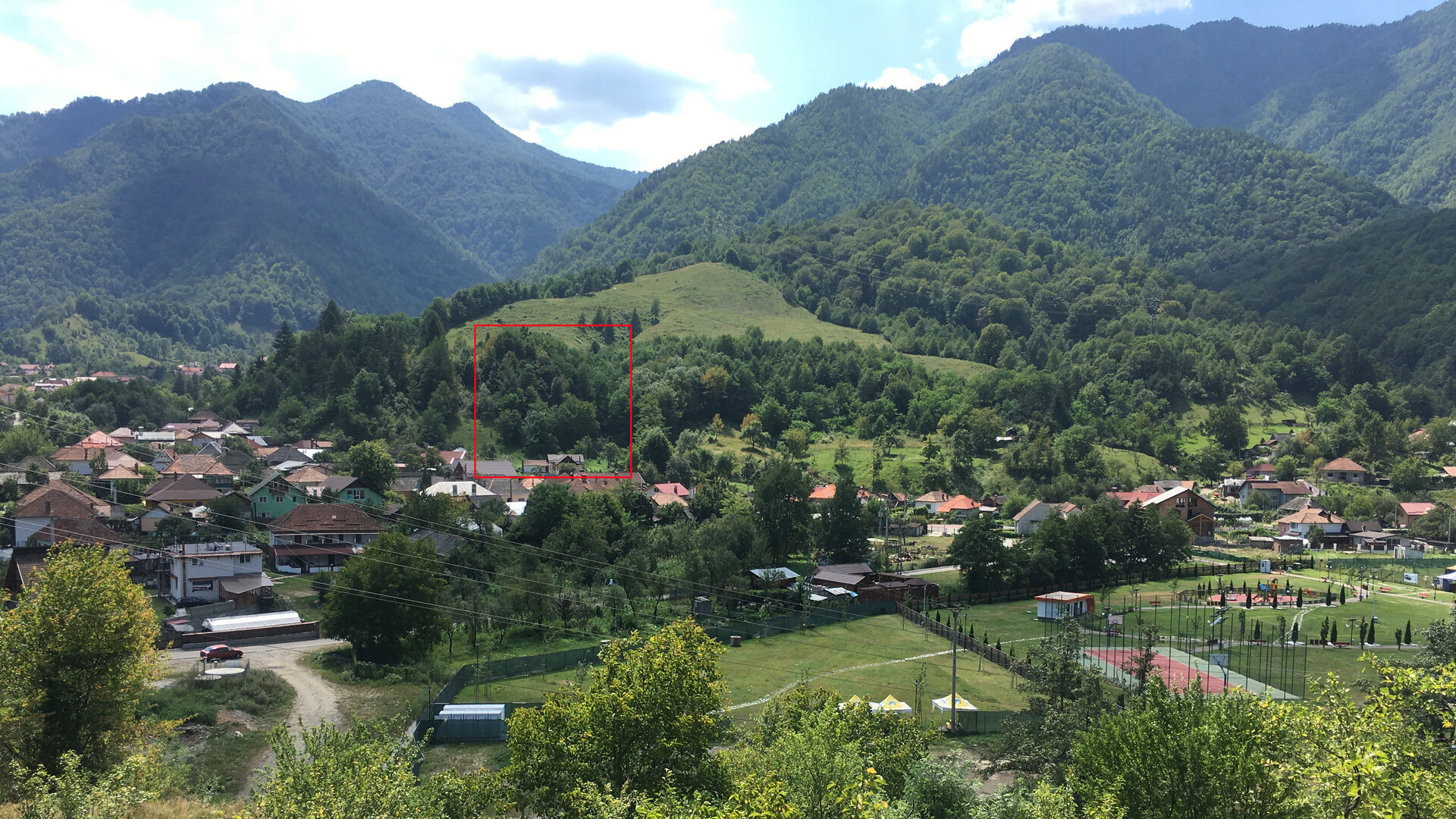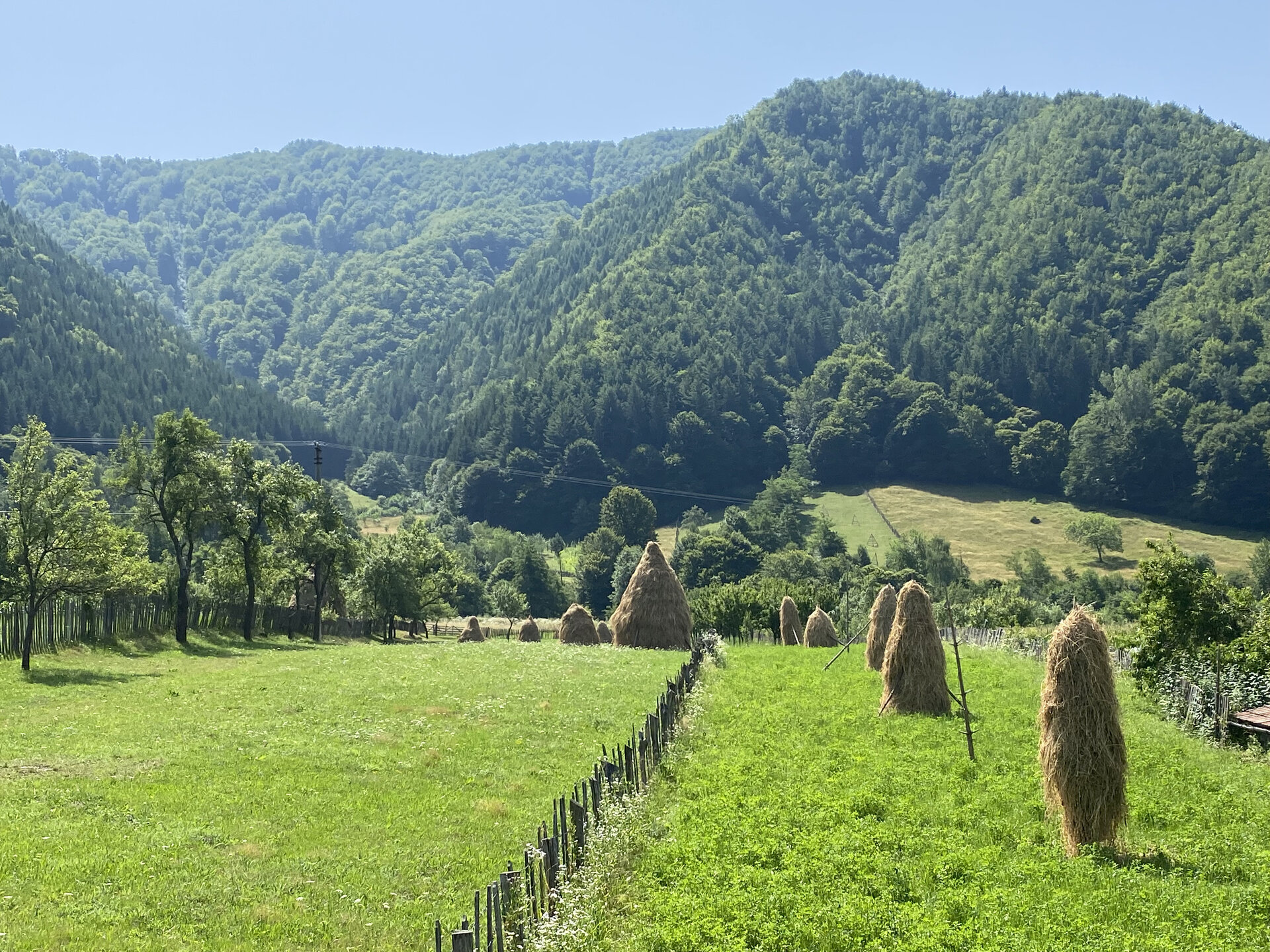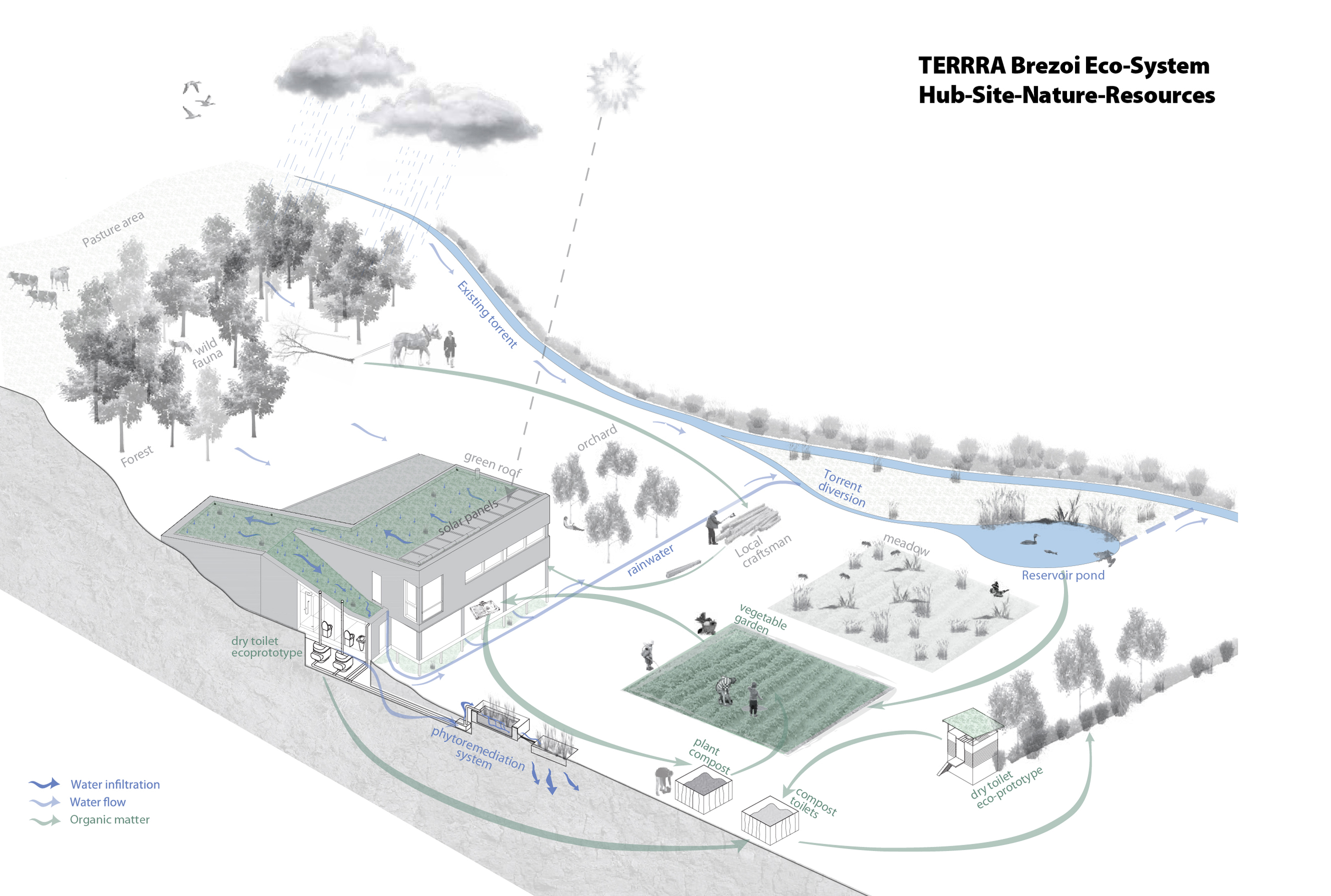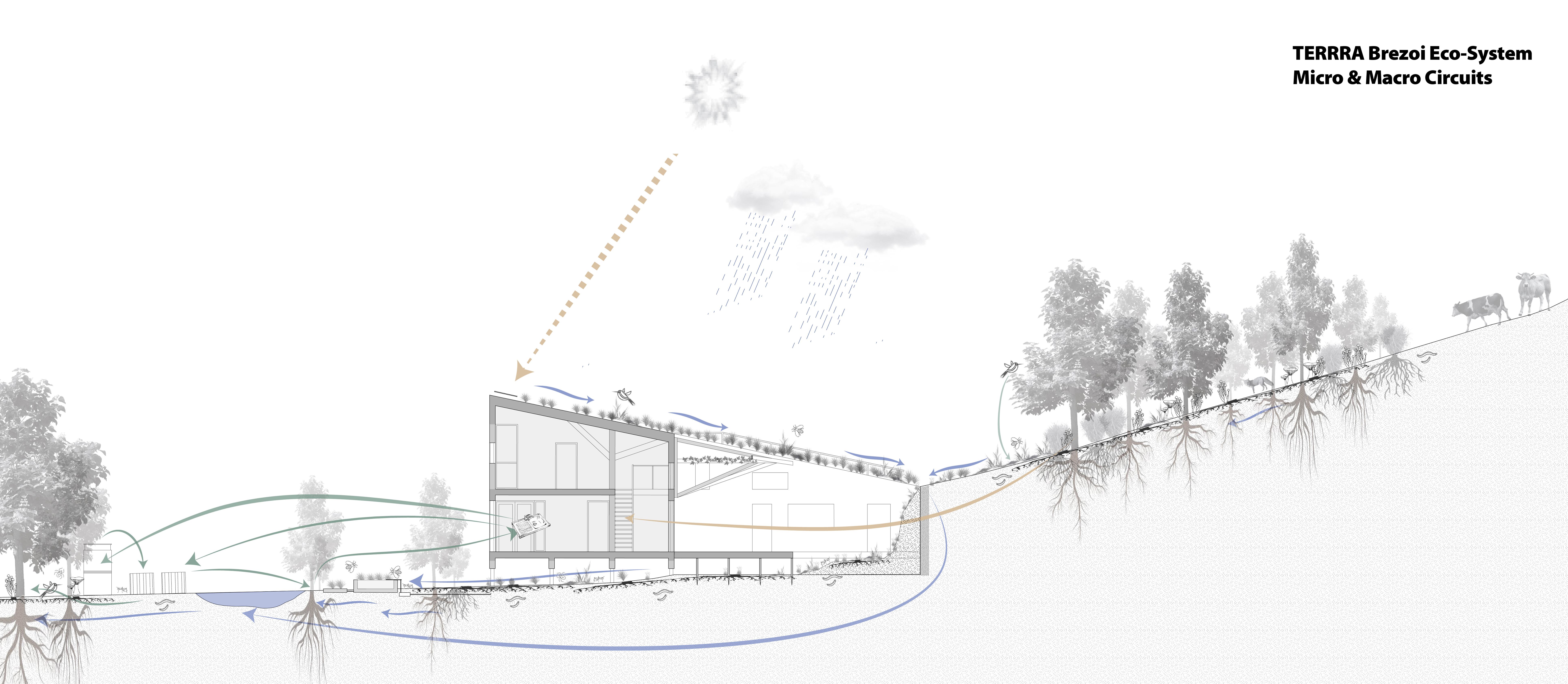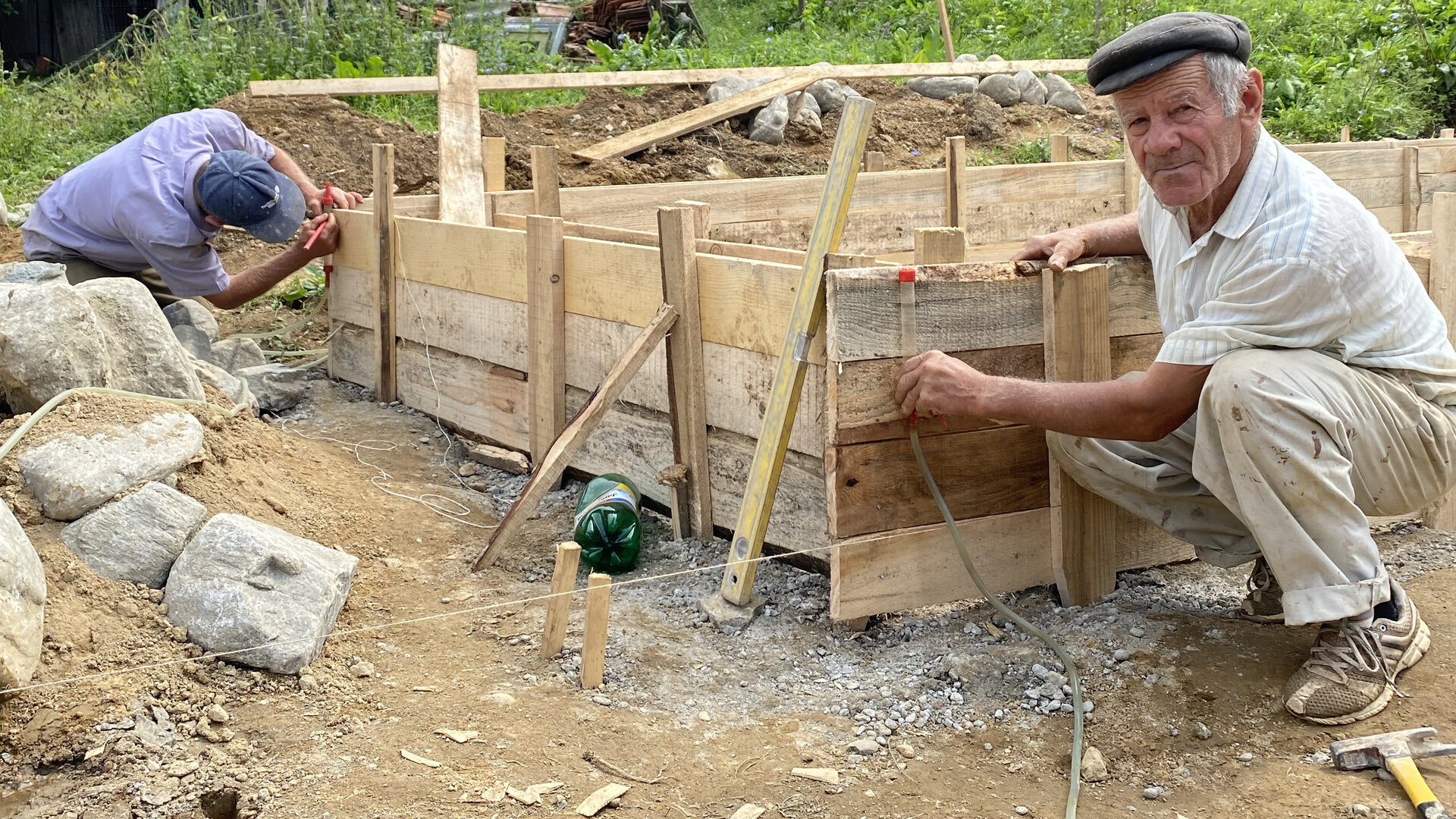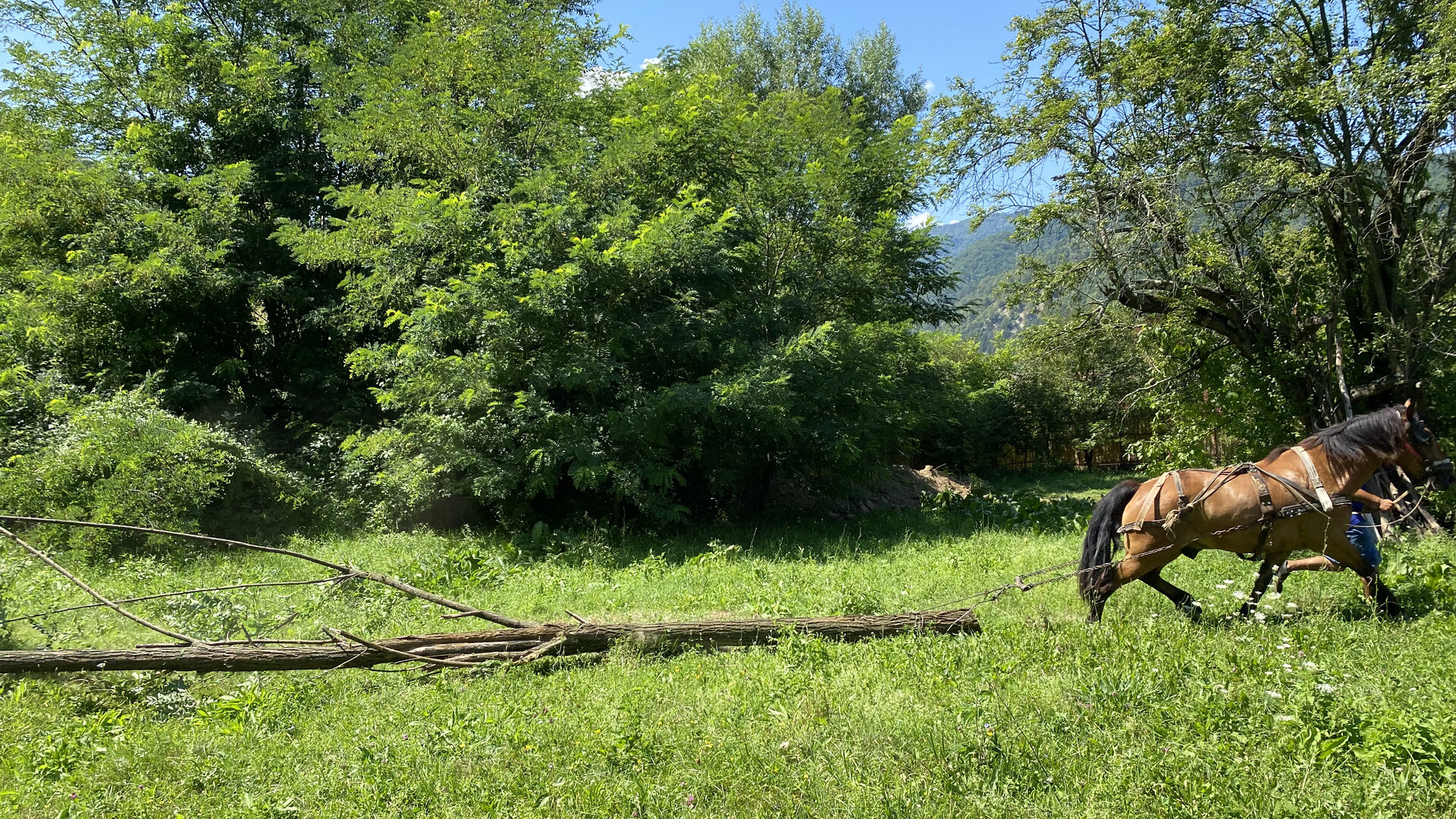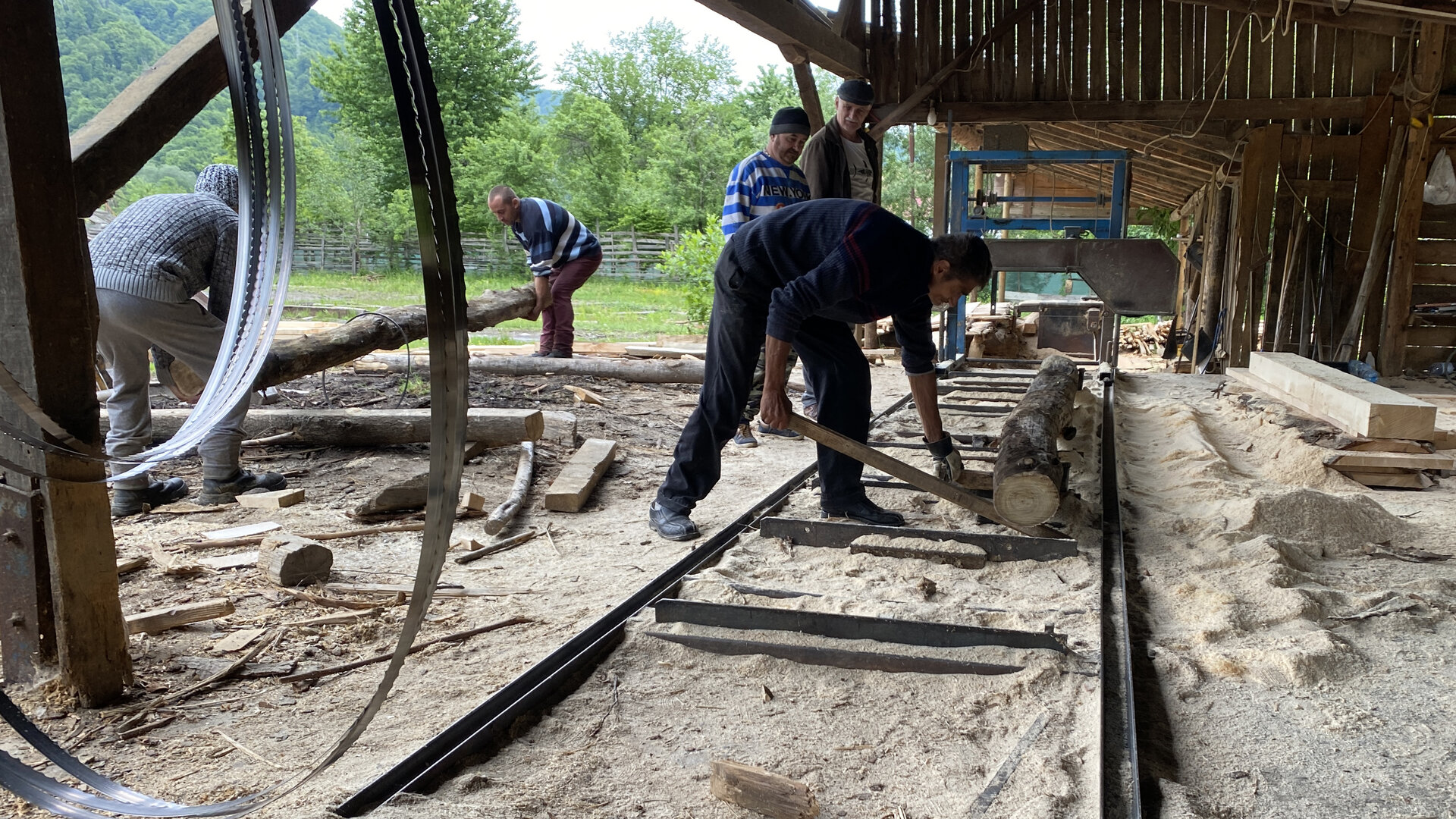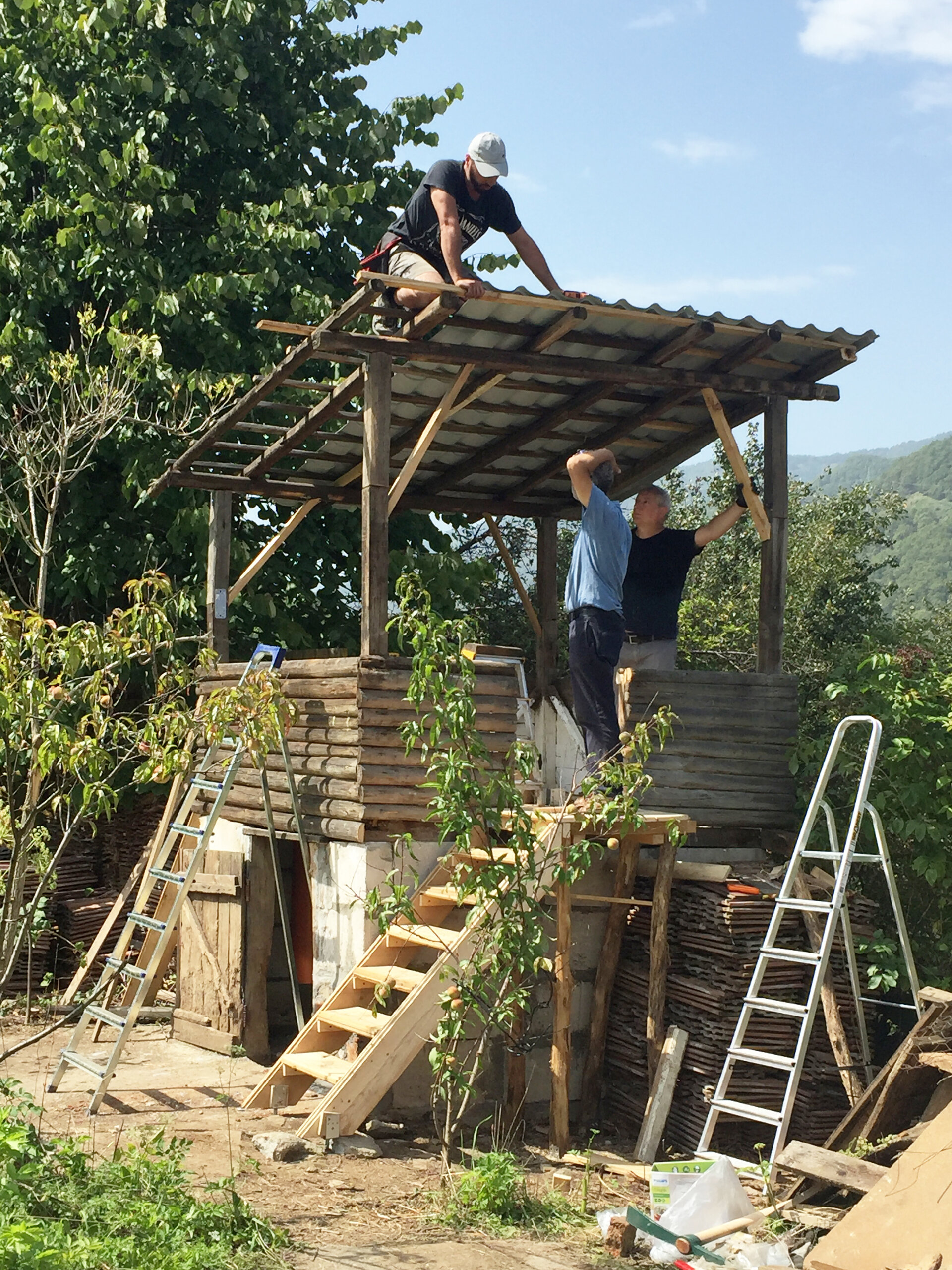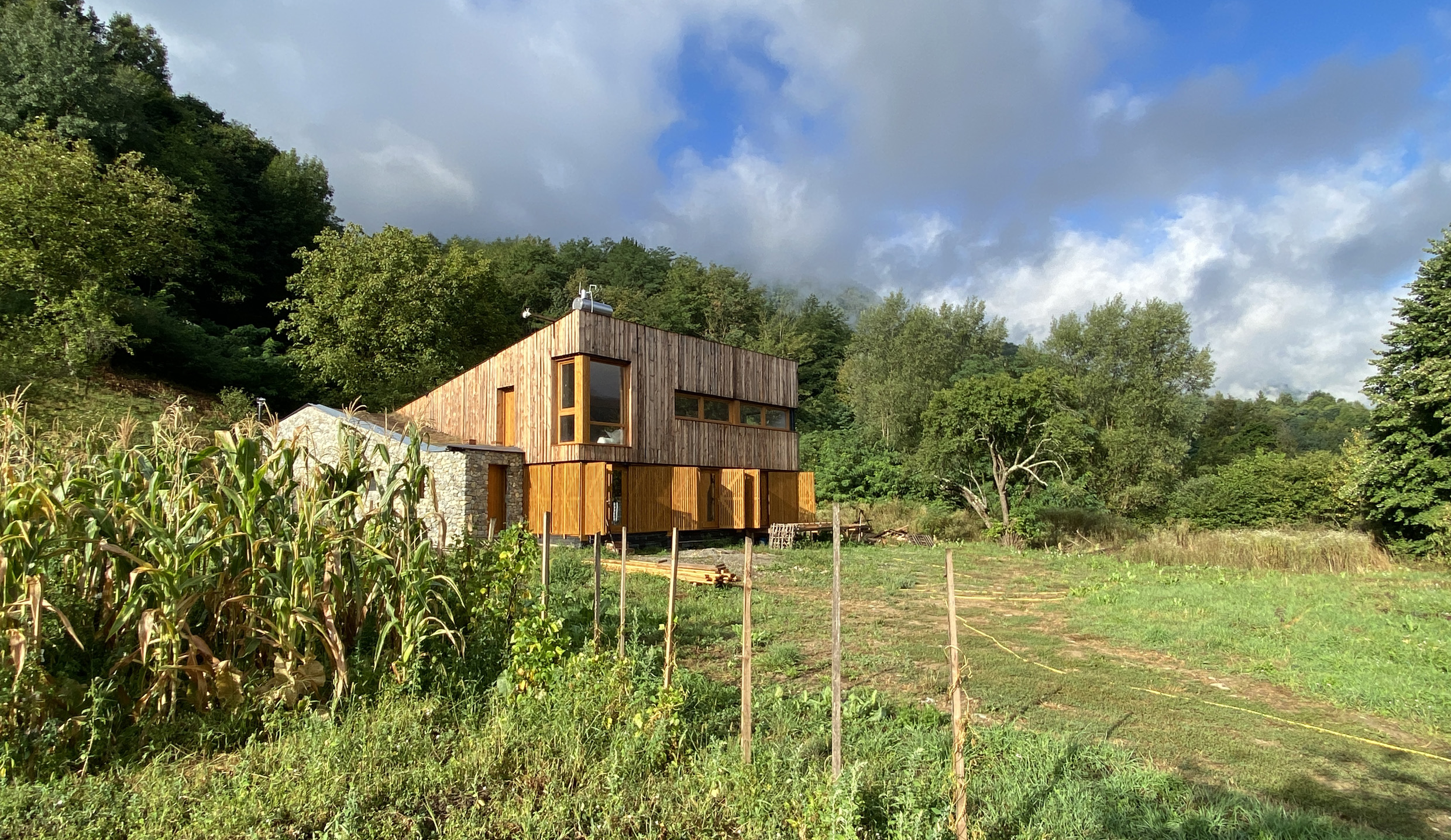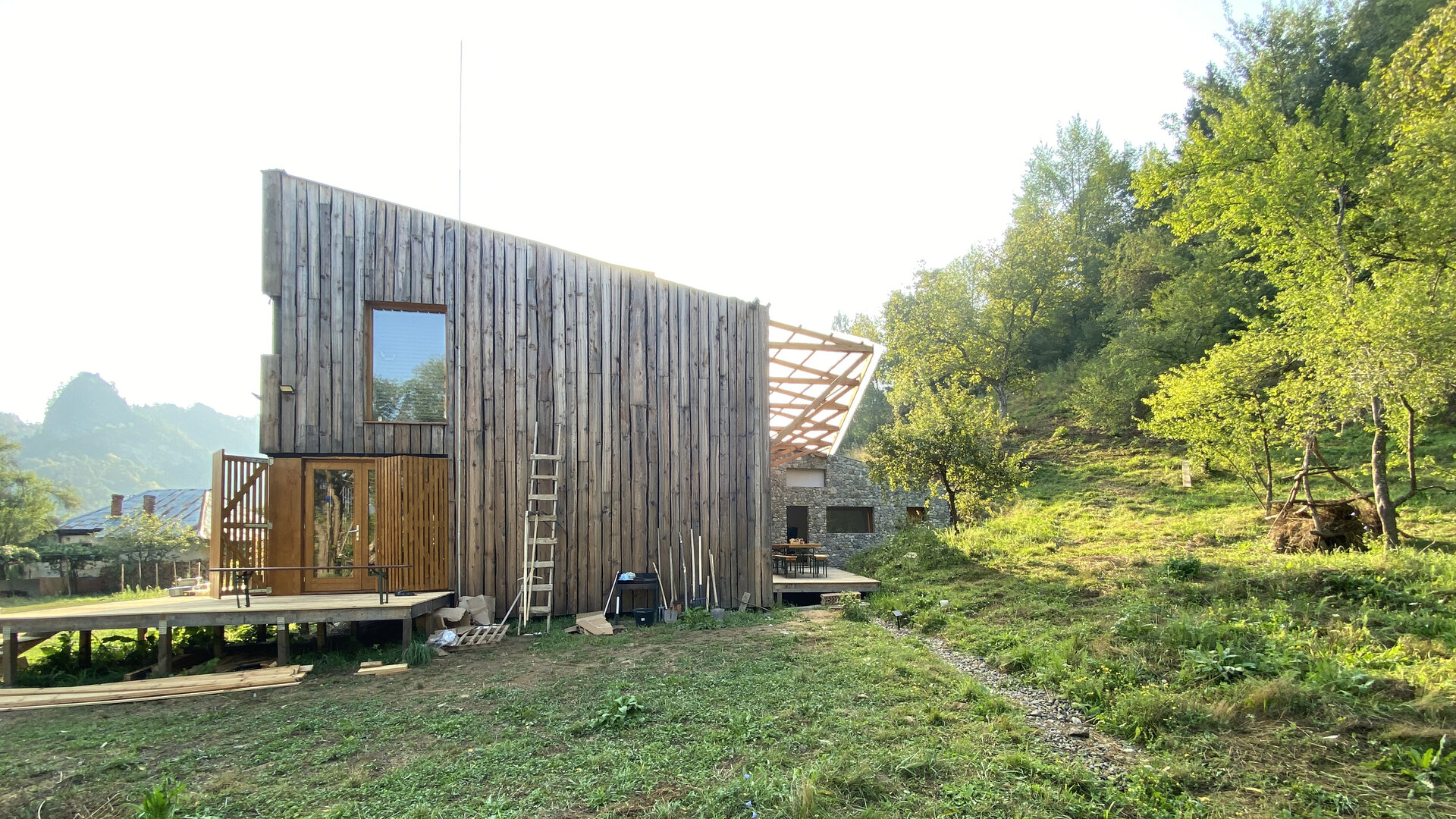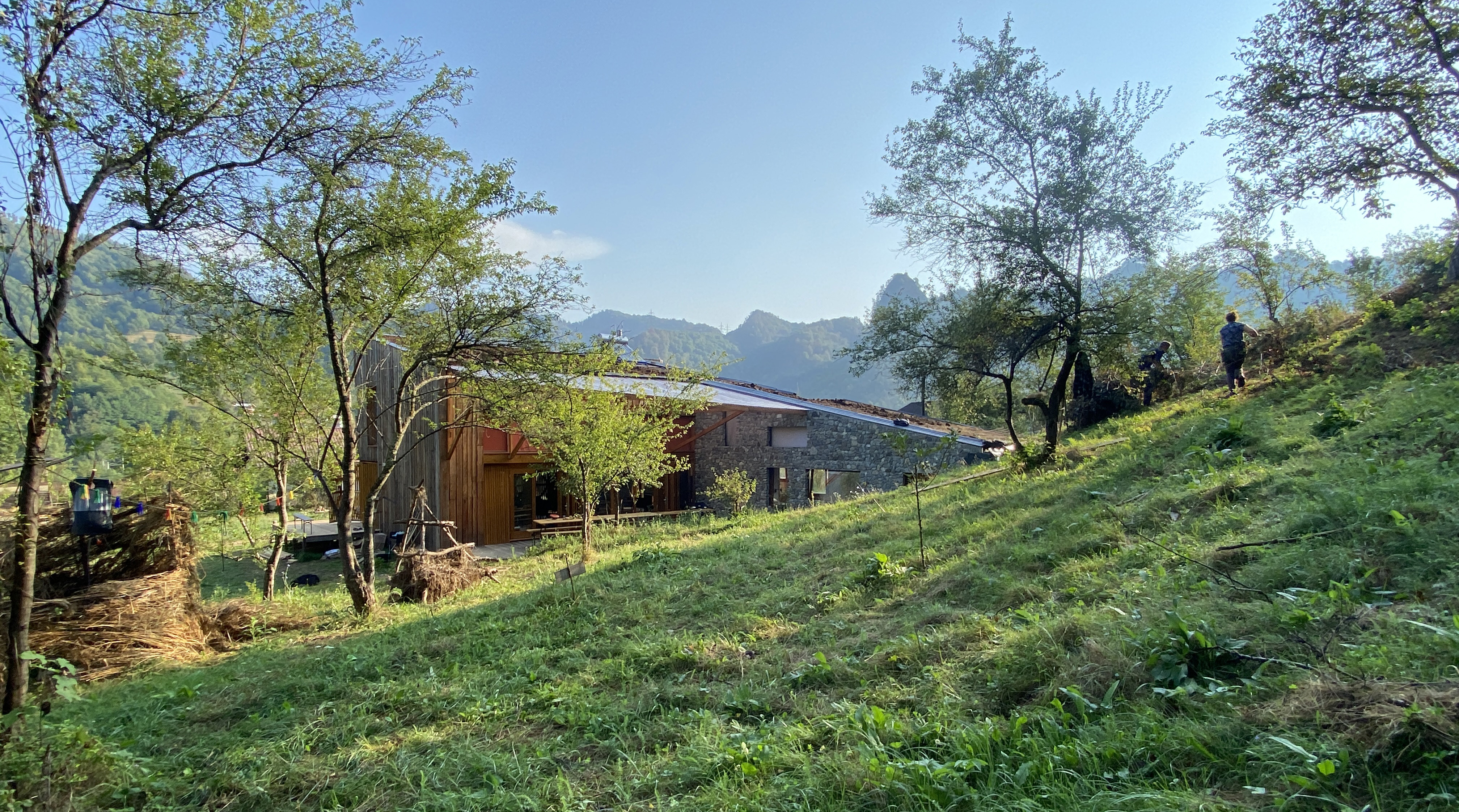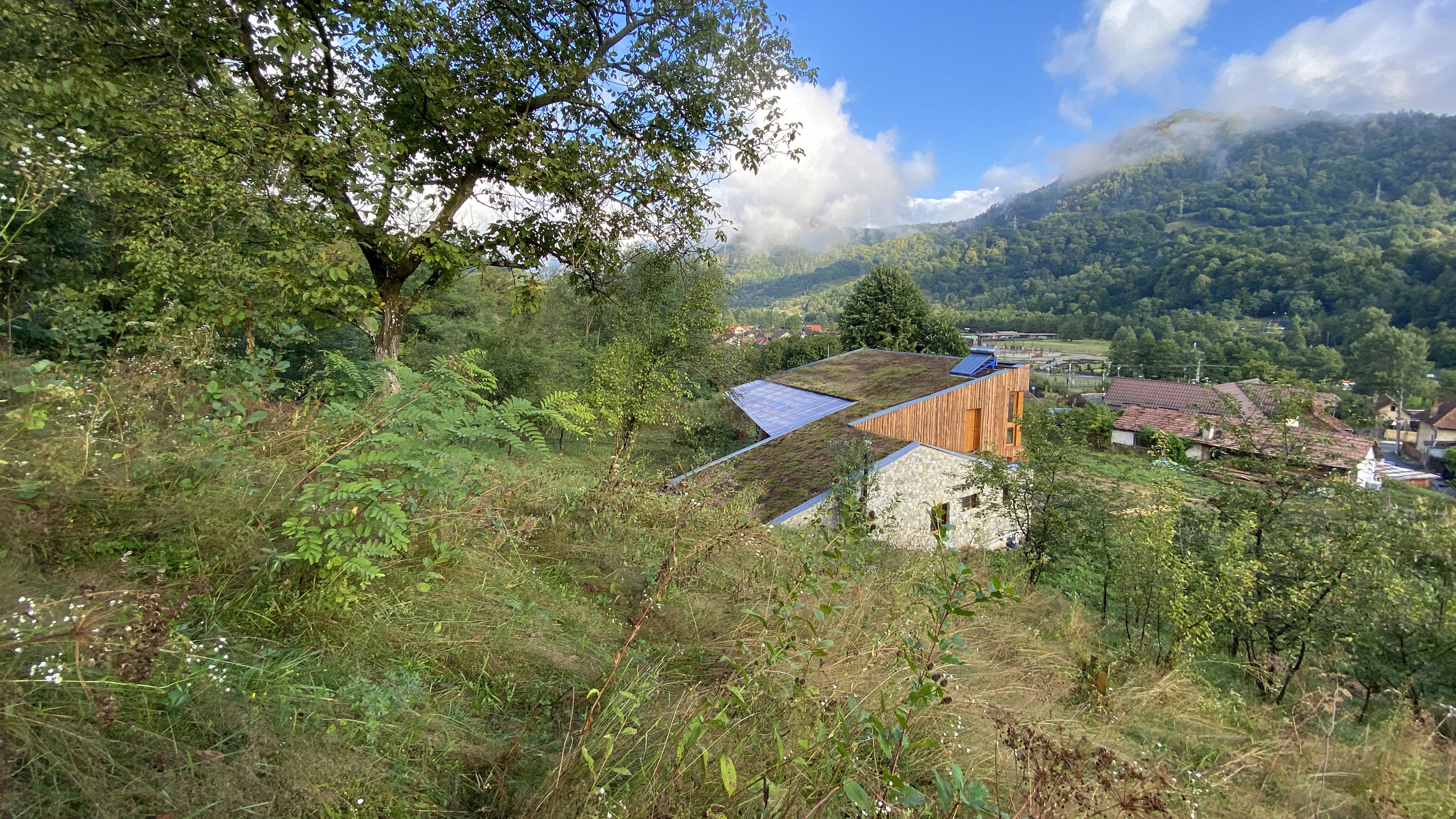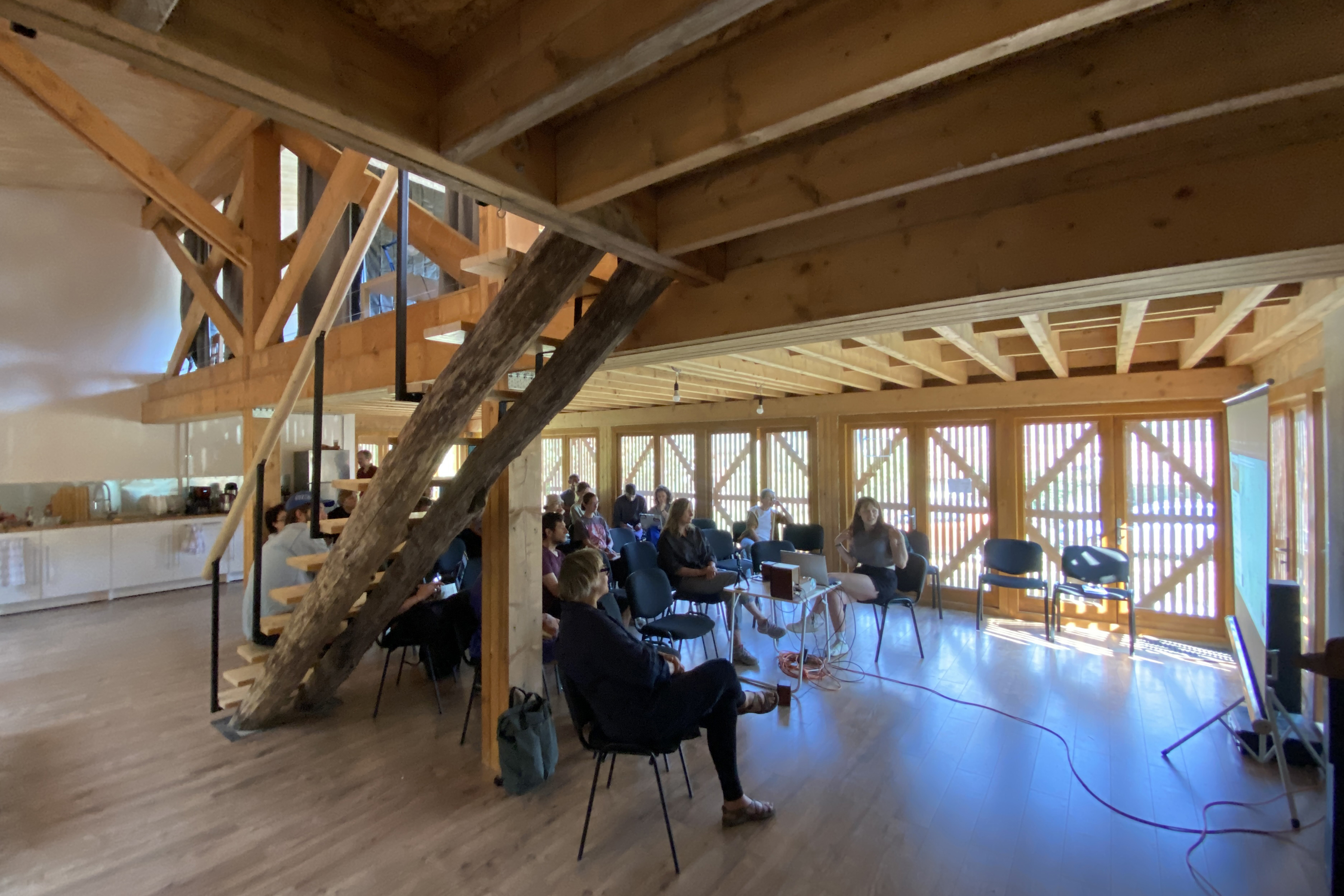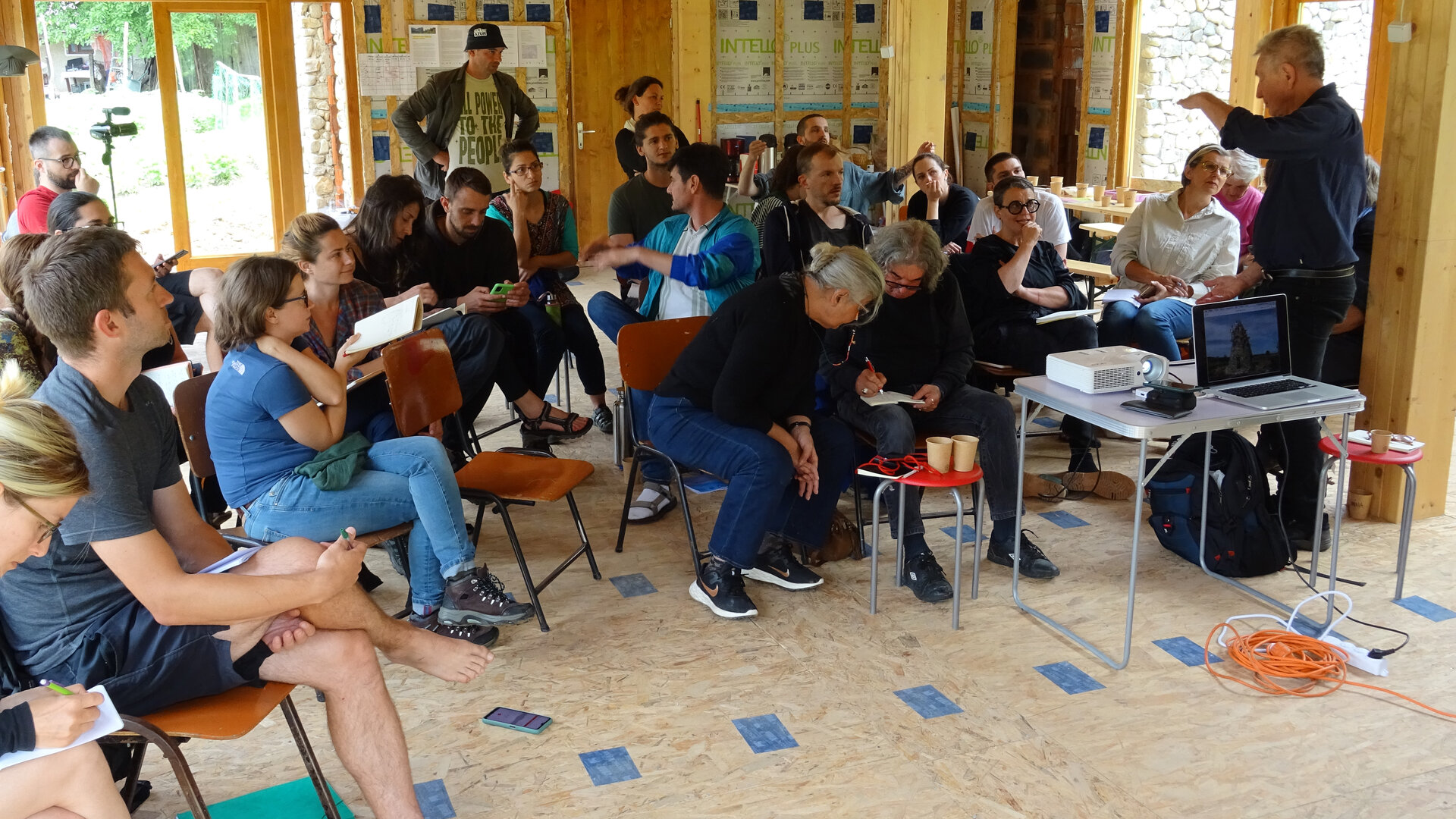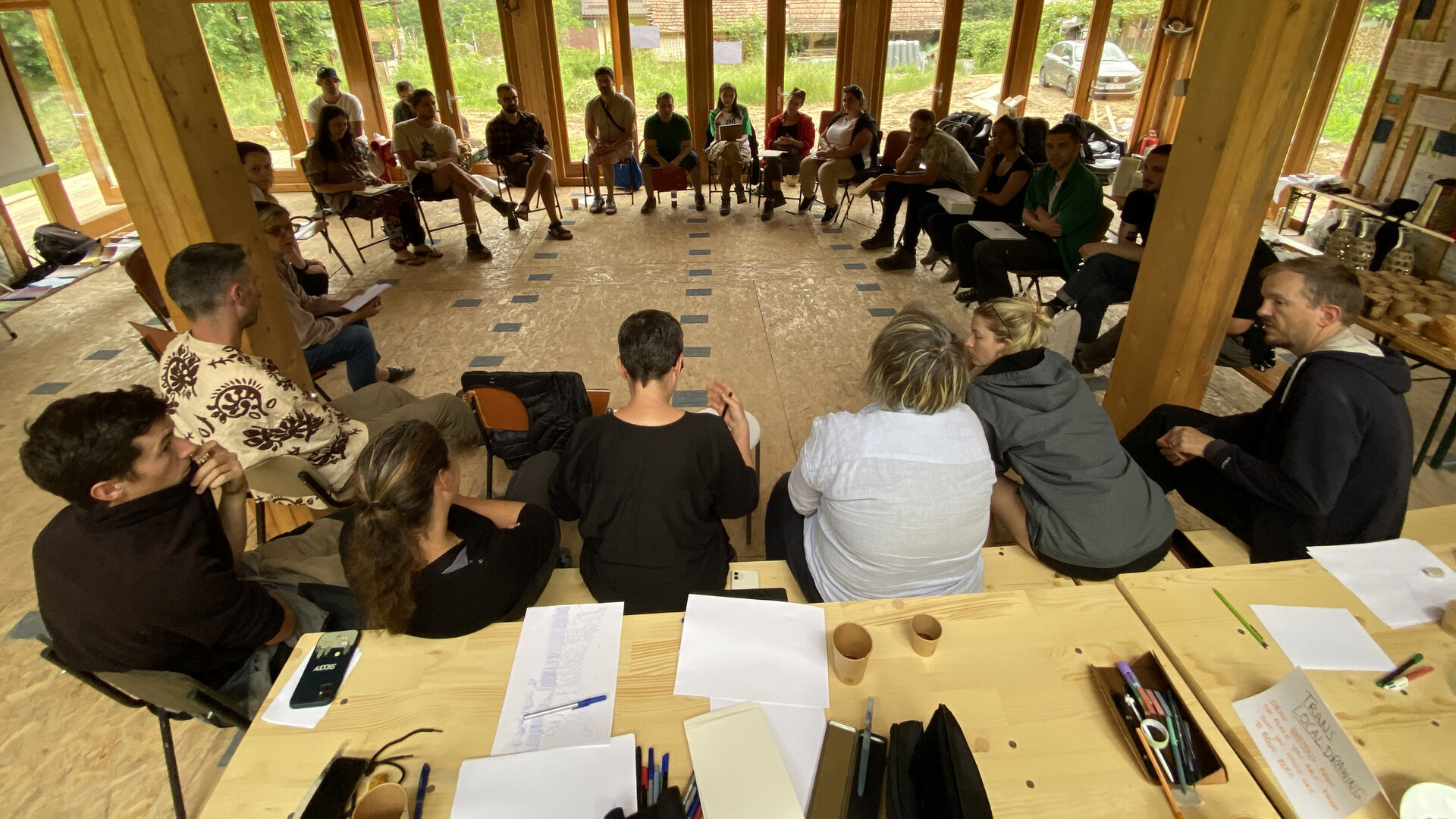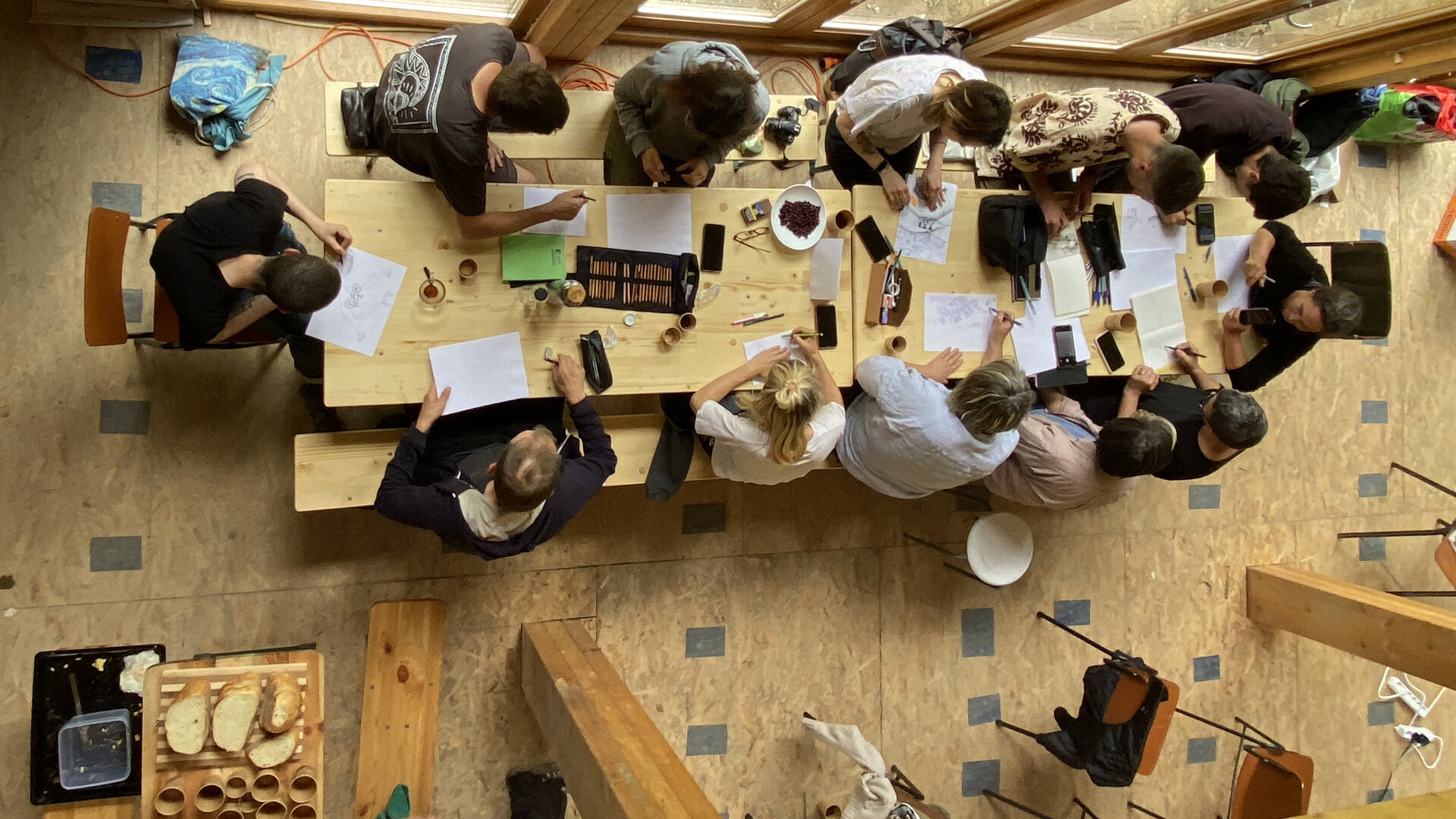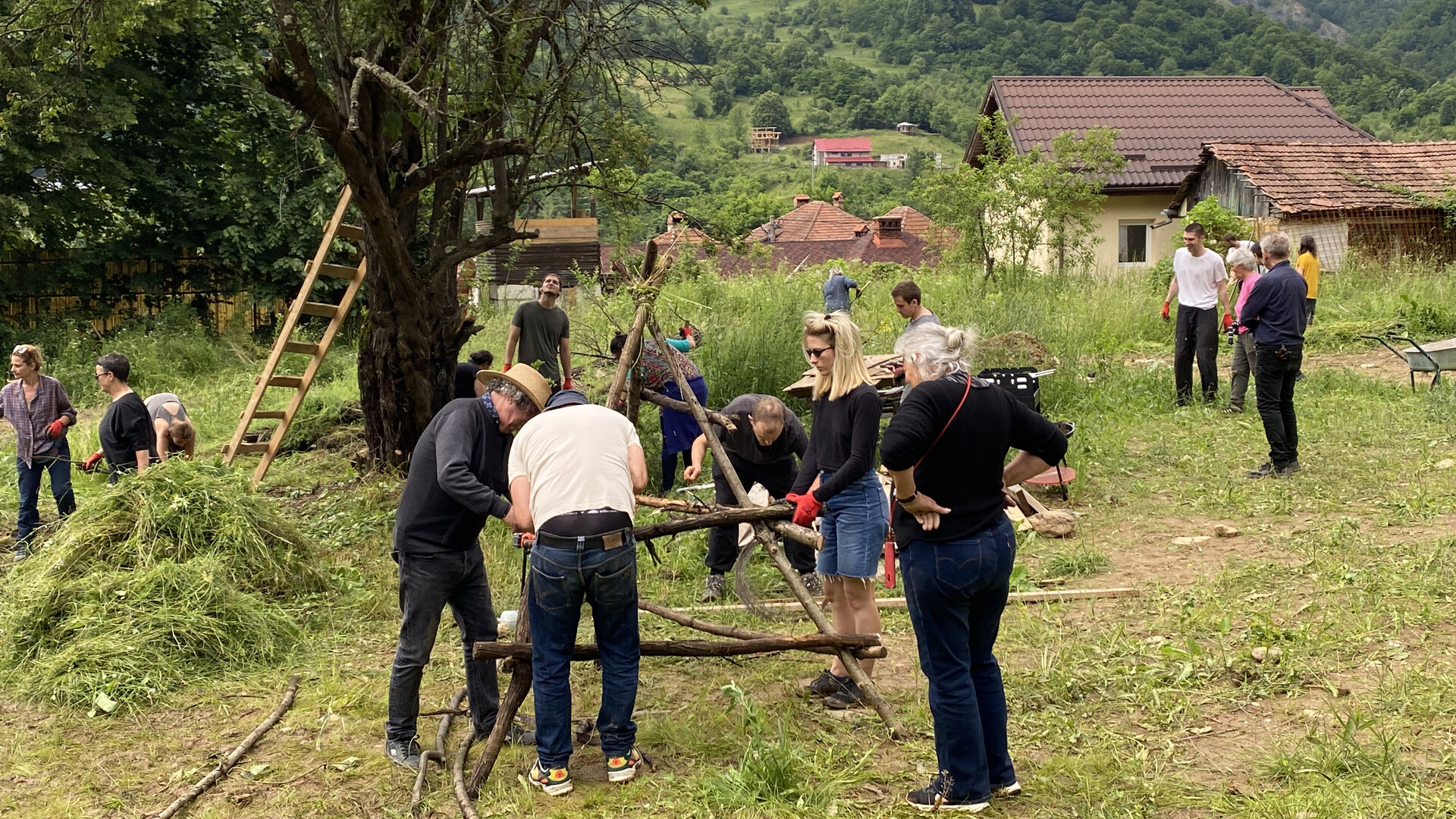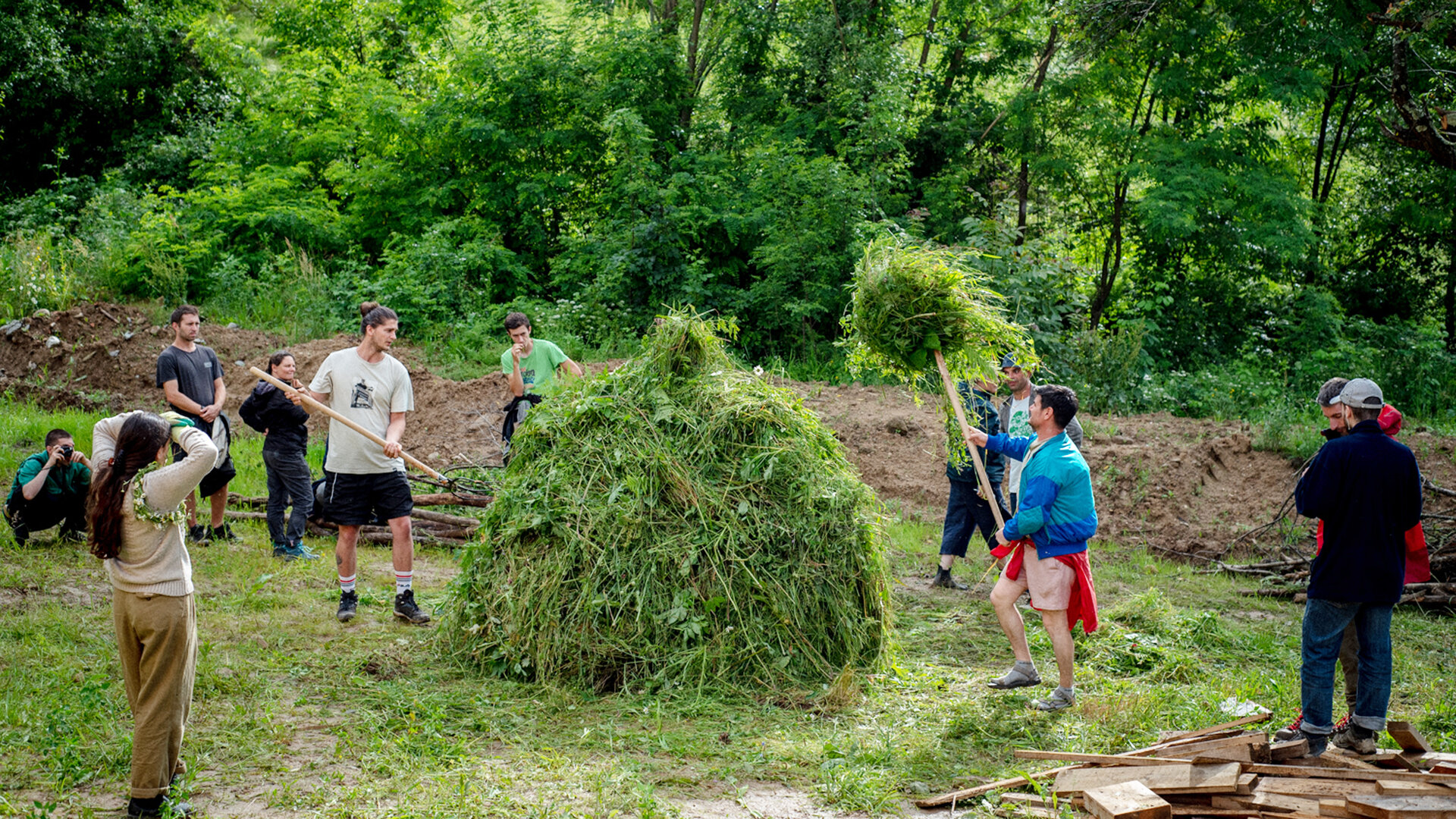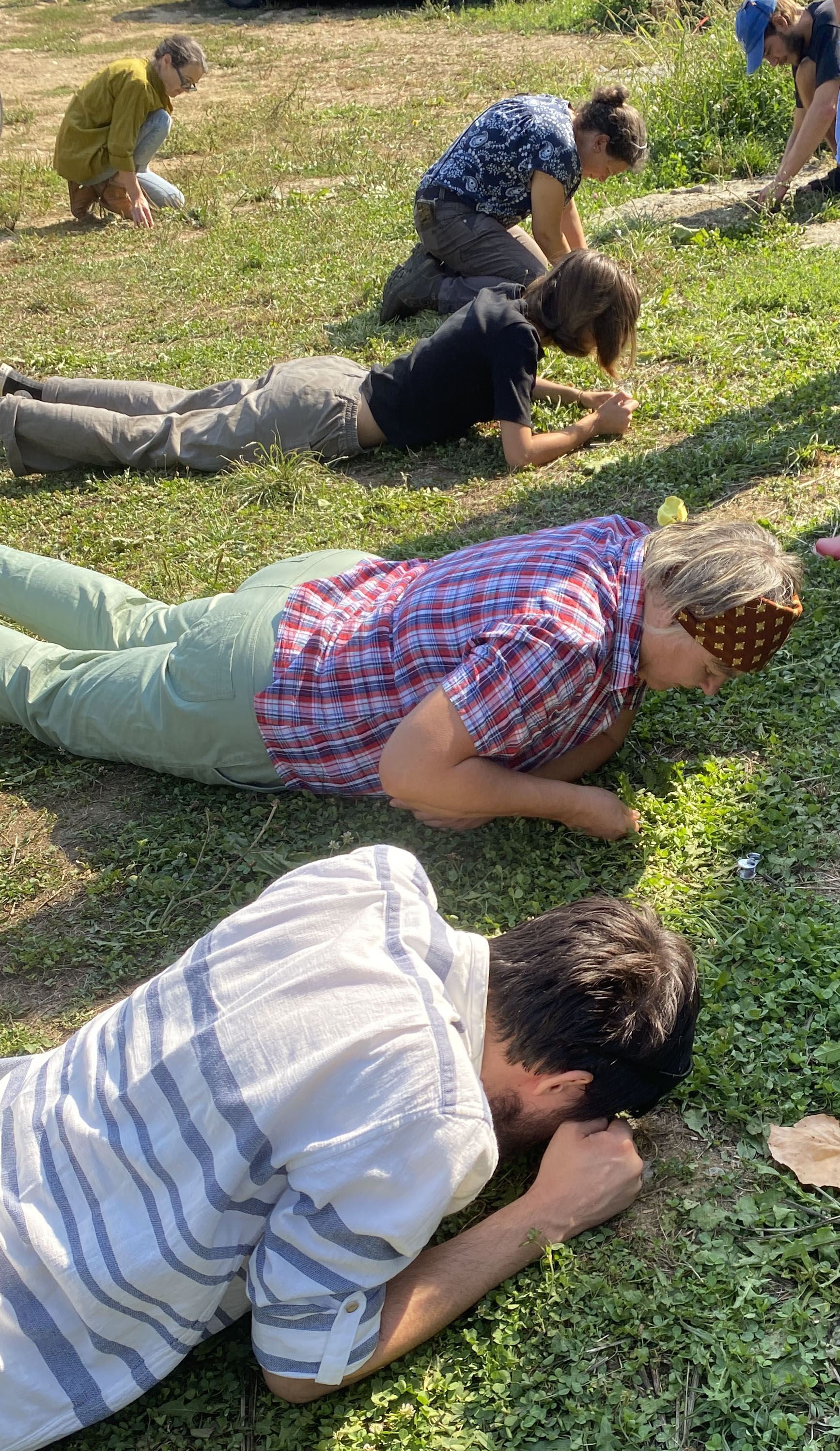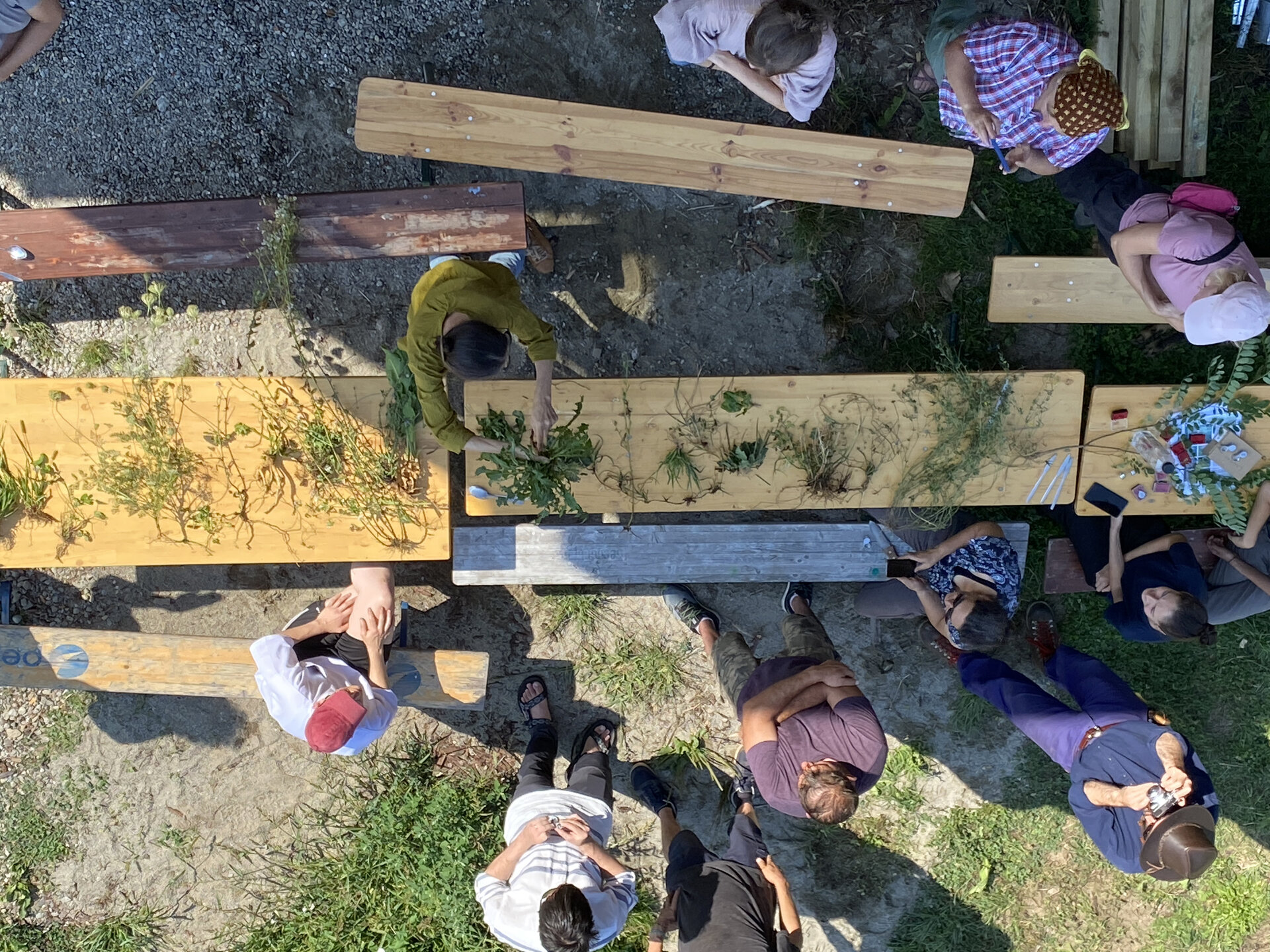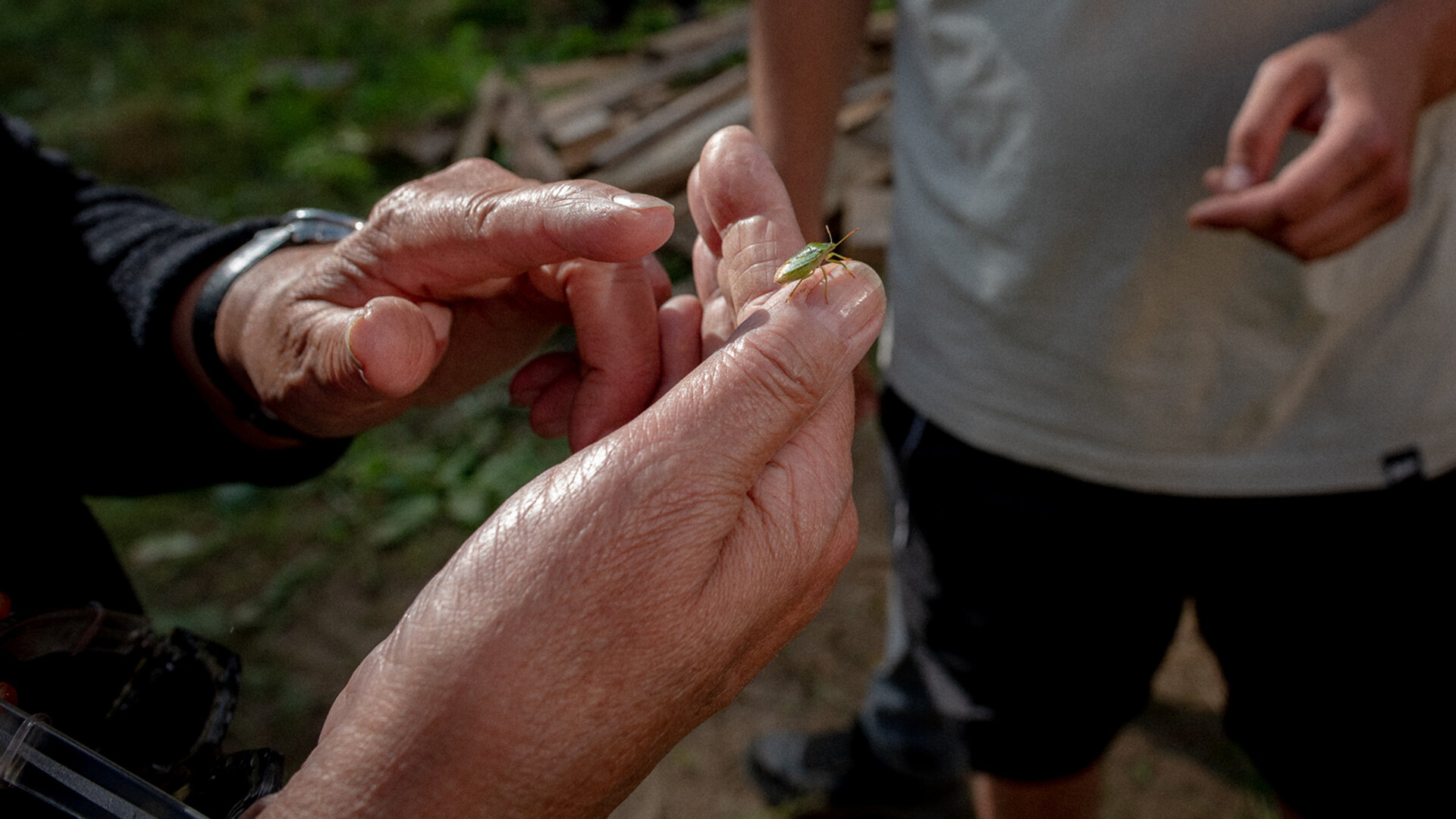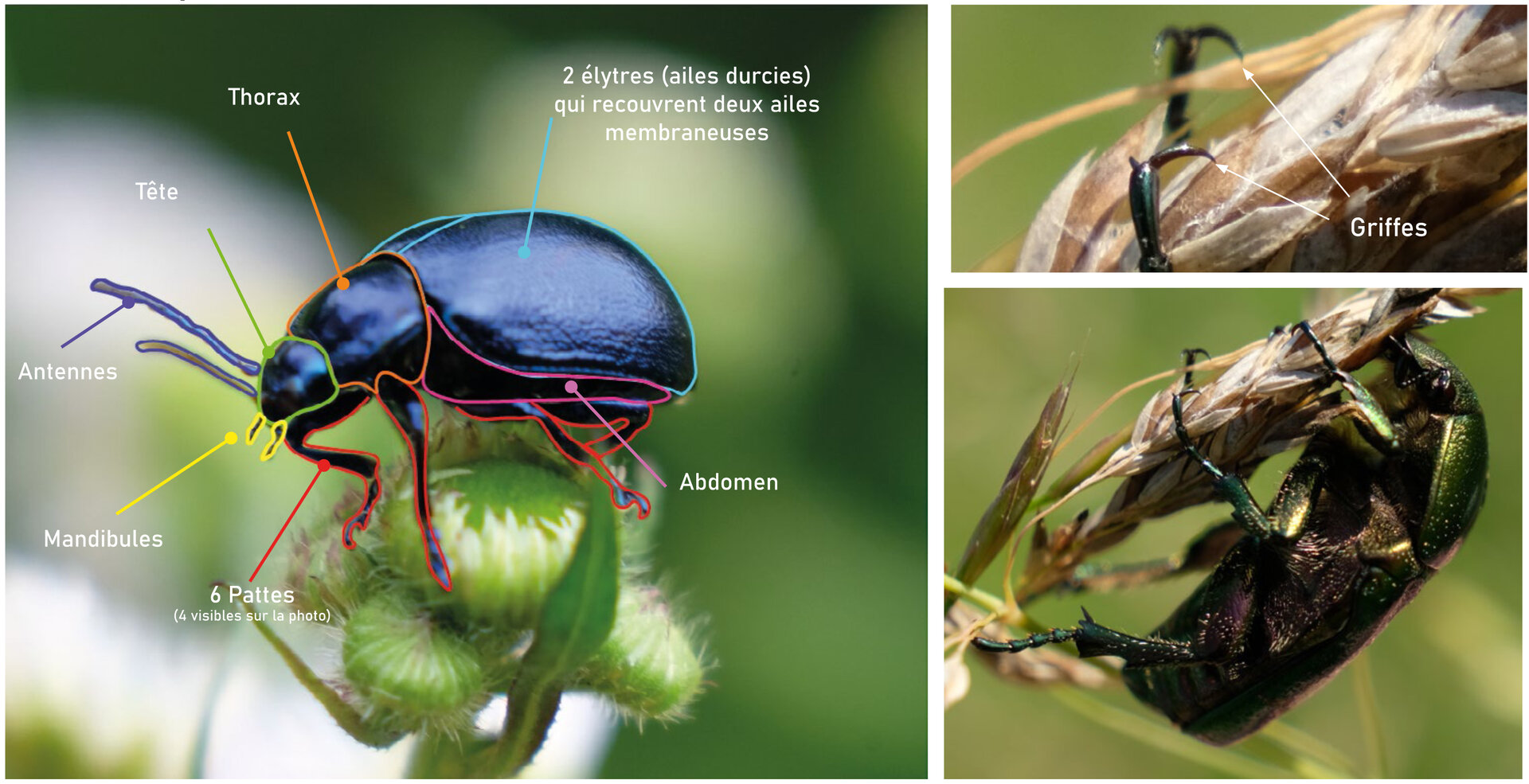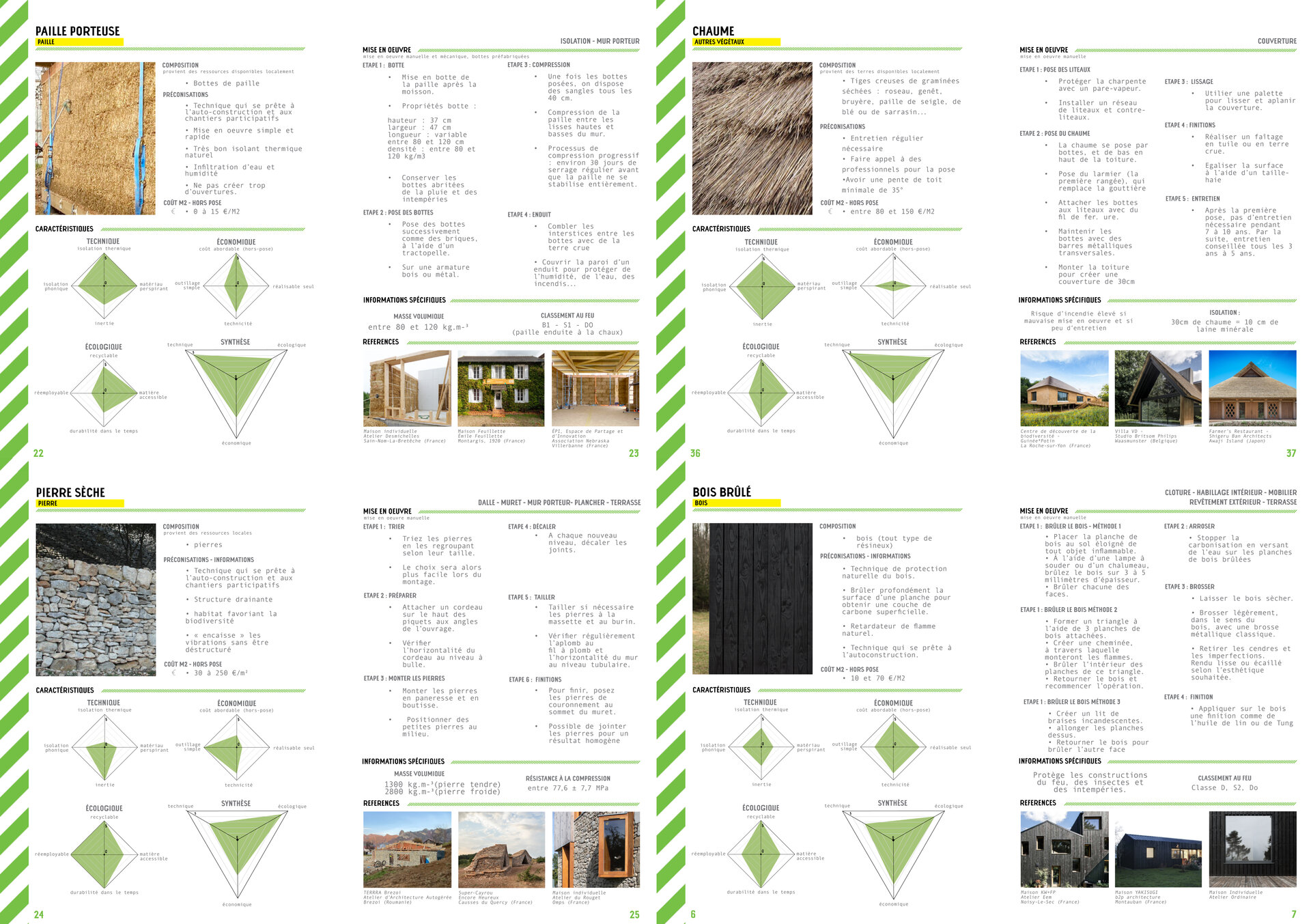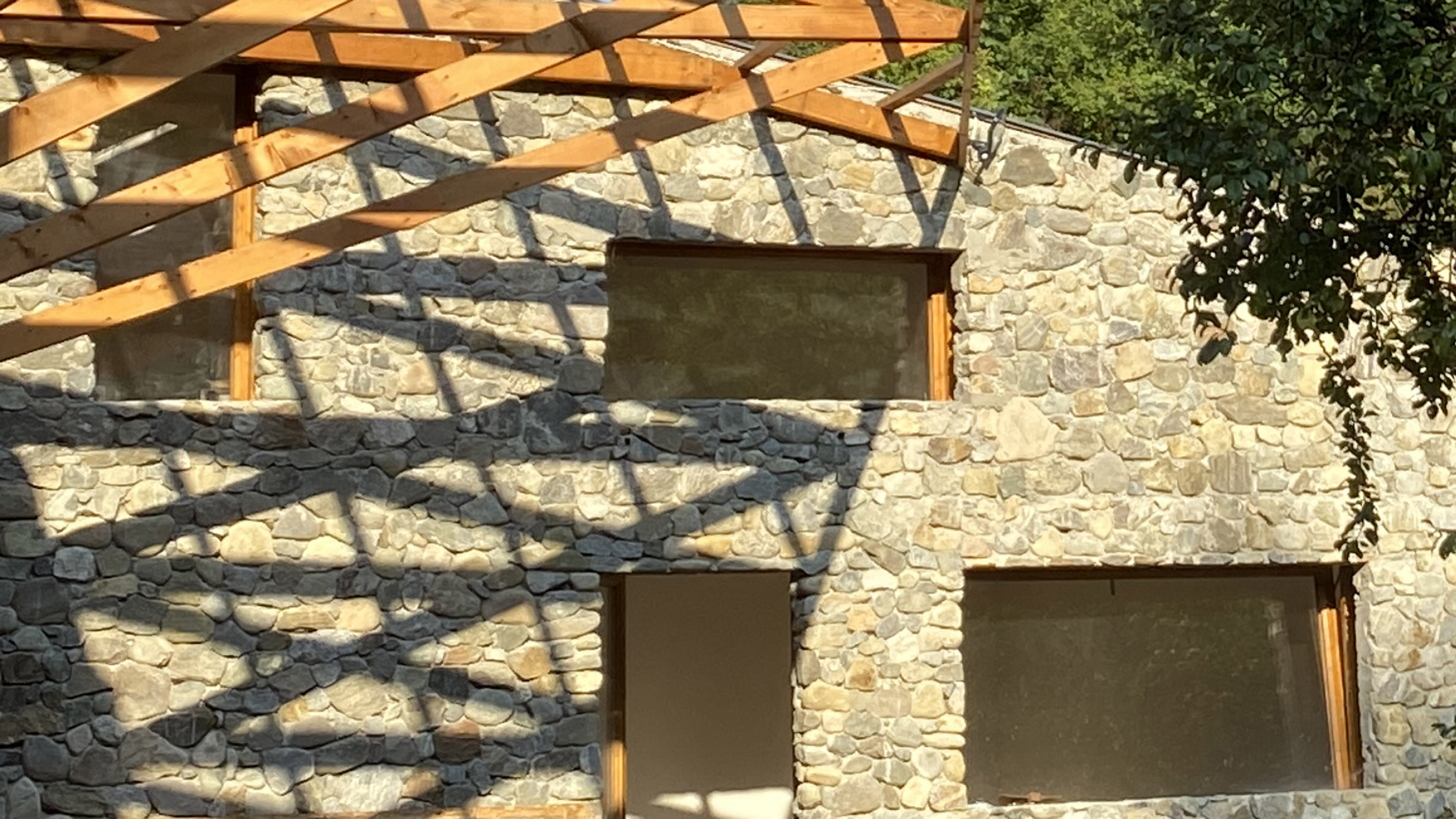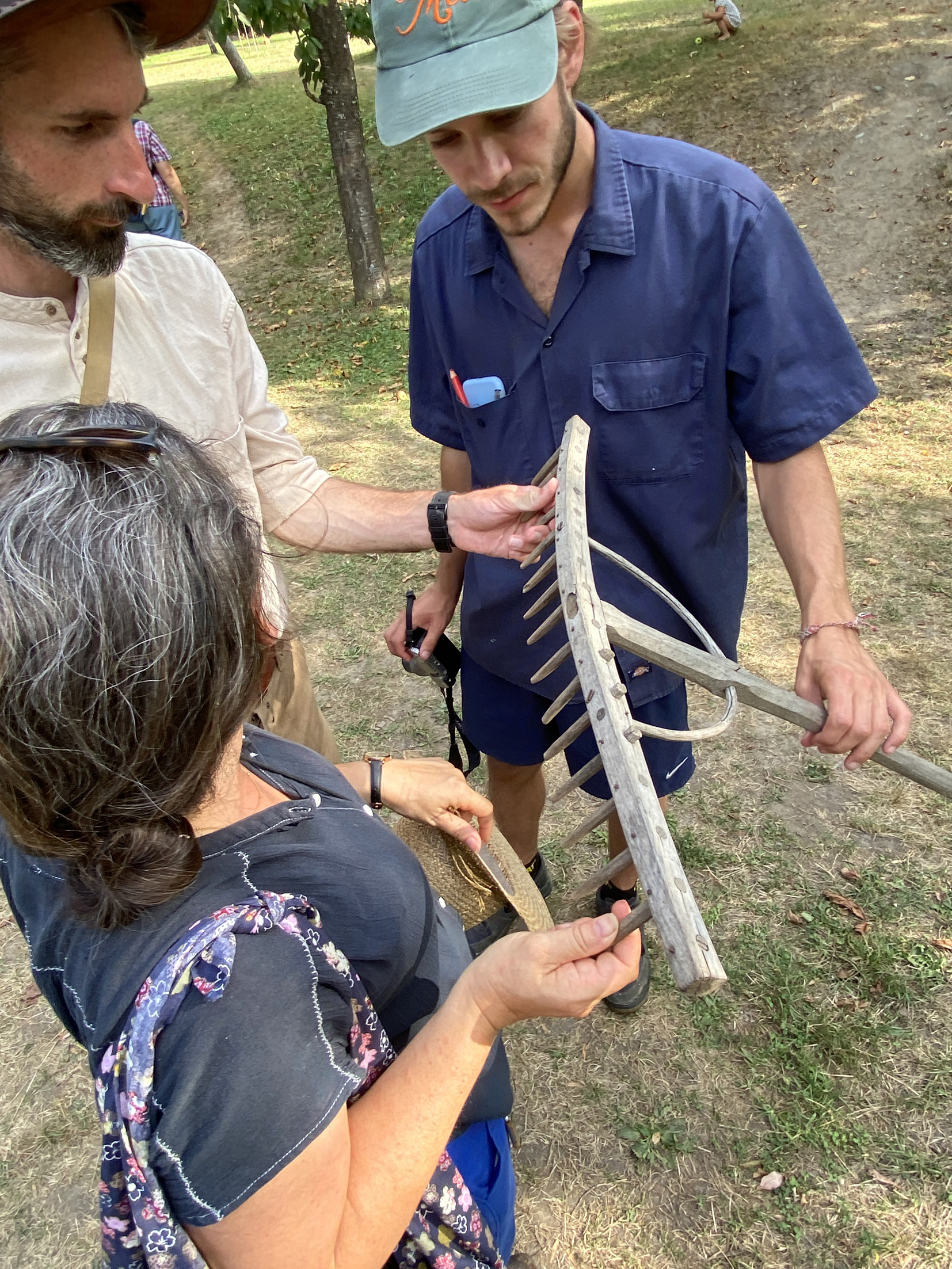Reconnecting with nature
TERRRA
TERRRA - A Hub for Popular Ecology and Resilient Restoration
TERRRA is a center for popular ecology located in a small Romanian town, dedicated to promoting low-tech approaches and traditional knowledge and skills in response to contemporary crises. The project conducts research and educational activities that foster new relationships with nature. It hosts a summer school, trans-disciplinary seminars and workshops, and provides residencies for researchers, architects, and artists, run in collaboration with various local and international stakeholders.
Romania
Local
BREZOI
Mainly rural
It refers to a physical transformation of the built environment (hard investment)
Yes
2025-01-30
No
No
No
As a representative of an organisation, in partnership with other organisations
TERRRA is a hub for popular ecology and a laboratory focused on ecological restoration and multispecies approaches within professional practices related to architecture, landscape, and the environment. It provides a space for learning how to contribute to planetary regeneration by fostering greater knowledge and interest in popular ecologies, while empowering citizens to actively participate in resilient transitions.
TERRRA Hub is located in Brezoi, a small-town of 6,000 residents in the Carpathian Mountains within the Lotru Valley. The town was home to a significant wood factory that closed in the 1990s, and it now faces considerable unemployment. The region is also known for having preserved ancient forms of collective management of forests and agricultural land.
The Hub sits on a 6,000 m2 site that includes a building dedicated to educational experimentation and research, featuring periodic seminars, workshops and annual residencies, and land for experimenting with agroecological and forestry techniques, as well as eco-prototyping. TERRRA hosts a local branch of the School of Planetary Gardeners, initiated by the French ecologist Gilles Clément. The free school creates a space for encounters between local practitioners, experts, young professionals, and students, where specialist knowledge meets local traditional knowledge through open pedagogical formats.
The newly built 200 m2 space—modeled after traditional barn designs—was constructed by local craftsmen using local materials and traditional building techniques (stone, wood, earth, hay) in the spirit of ecological and economic circularity.
The site also hosts several sustainable eco-prototypes, such as dry toilets, grey water phytoremediation, soil and water management systems. The project emphasizes ecological (and cultural) restoration in a post-industrial small town and rural area, understanding ecology in a broad sense, as encompassing environmental, social, and cultural dimensions.
TERRRA Hub is located in Brezoi, a small-town of 6,000 residents in the Carpathian Mountains within the Lotru Valley. The town was home to a significant wood factory that closed in the 1990s, and it now faces considerable unemployment. The region is also known for having preserved ancient forms of collective management of forests and agricultural land.
The Hub sits on a 6,000 m2 site that includes a building dedicated to educational experimentation and research, featuring periodic seminars, workshops and annual residencies, and land for experimenting with agroecological and forestry techniques, as well as eco-prototyping. TERRRA hosts a local branch of the School of Planetary Gardeners, initiated by the French ecologist Gilles Clément. The free school creates a space for encounters between local practitioners, experts, young professionals, and students, where specialist knowledge meets local traditional knowledge through open pedagogical formats.
The newly built 200 m2 space—modeled after traditional barn designs—was constructed by local craftsmen using local materials and traditional building techniques (stone, wood, earth, hay) in the spirit of ecological and economic circularity.
The site also hosts several sustainable eco-prototypes, such as dry toilets, grey water phytoremediation, soil and water management systems. The project emphasizes ecological (and cultural) restoration in a post-industrial small town and rural area, understanding ecology in a broad sense, as encompassing environmental, social, and cultural dimensions.
1 popular ecology
2 civic learning
3 traditional skills
4 resilient restoration
5 trans-local network
TERRRA meets sustainability objectives both in terms of construction principles and site implementation, management and use.
The Hub’s structure combines stone and wood, utilizing traditional construction methods and local materials and skills. An important principle is the circularity of materials, which are all local and biosourced (wood, earth, straw and stone from the site or the region) or reused (wood and metal, construction waste). We have also employed local skills, resources and knowledge by involving local craftsmen, with a focus on using low-tech and reduced energy approaches (eg. manual tools, animal traction, solar energy).The building configuration adopts a bioclimatic approach in terms of orientation, shading and sun protection, natural insulation, day/night balance and natural ventilation.
A green roof integrates the hilly landscape, being planted with local wild seeds for natural growth. In general, the landscape design reflects a commitment to minimal intervention and biodiversity preservation, with a well-informed strategy that maps existing species and their interrelations in a balanced forest/pasture/orchard/garden ecosystem.
The water management strategies address climate-related hydrological challenges, involving the diversion of existing torrents, the creation of ponds and retention thresholds, and a system of mini-canals to allow for 100% rainwater collection and use for the garden. Additionally, 75% of the construction footprint remains permeable and host micro-flora, thanks to the use of a micro-pillar foundation system.
Circular waste management practices are implemented through nature-based solutions, including different types of composting, dry toilets, grey water pytoremediation and the use of straw from the land. As such 95% of the organic waste is recycled on site.
This approach aligns with the hub’s purpose as a centre for popular ecology which holds in its name the commitment to the planet and the 3 ecological ‘R’s.
The Hub’s structure combines stone and wood, utilizing traditional construction methods and local materials and skills. An important principle is the circularity of materials, which are all local and biosourced (wood, earth, straw and stone from the site or the region) or reused (wood and metal, construction waste). We have also employed local skills, resources and knowledge by involving local craftsmen, with a focus on using low-tech and reduced energy approaches (eg. manual tools, animal traction, solar energy).The building configuration adopts a bioclimatic approach in terms of orientation, shading and sun protection, natural insulation, day/night balance and natural ventilation.
A green roof integrates the hilly landscape, being planted with local wild seeds for natural growth. In general, the landscape design reflects a commitment to minimal intervention and biodiversity preservation, with a well-informed strategy that maps existing species and their interrelations in a balanced forest/pasture/orchard/garden ecosystem.
The water management strategies address climate-related hydrological challenges, involving the diversion of existing torrents, the creation of ponds and retention thresholds, and a system of mini-canals to allow for 100% rainwater collection and use for the garden. Additionally, 75% of the construction footprint remains permeable and host micro-flora, thanks to the use of a micro-pillar foundation system.
Circular waste management practices are implemented through nature-based solutions, including different types of composting, dry toilets, grey water pytoremediation and the use of straw from the land. As such 95% of the organic waste is recycled on site.
This approach aligns with the hub’s purpose as a centre for popular ecology which holds in its name the commitment to the planet and the 3 ecological ‘R’s.
TERRRA’s site design highlights the aesthetic qualities of the location. Its architecture celebrates an open view over the village and the mountains while preserving the continuity between the forested hill and the building. The landscape integration is also reflected in the site organization, which respects the existing natural elements (forest, meadow, orchard, vegetable garden, creek) and their biodiversity corridors. The site organisation preserves the layout of traditional households with their various components, as well as the necessary dialogue between the ‘wild’ and the ‘domestic’ as an ethnographic conservation principle. The building’s configuration makes visible the ecological circuits of the site (water, energy, waste, etc.), while also respecting local climatic principles (sunlight, shade, rain, snow, etc.).
The project advocates for an architectural approach that utilizes local resources (materials, knowledge, labor, etc.), integrating local aesthetics and creativity. This results in a building that, through its assembling techniques, showcases local skills and tools, directly supporting local craftsmanship. The beauty of these materials, crafts, and techniques is reinterpreted in a contemporary manner through careful execution and attention to detail, leading to an aesthetic visible in the construction of various elements (e.g., stone walls, wood cladding, shutters, stairs) that are both contemporary and ‘local’. This aesthetic is also minimalist and economical, with a simple fabrication process that allows for repair and reversibility. The repair approach has been applied in the restoration of some of the old annexes, such as the ancient poultry house, which has been aestehtically revalorised while being transformed into a dry toilet.
TERRRA proposes an original aesthetic that is both new and reflective of local tradition, sustainable, comfortable, and economical, while fully respecting nature and its dynamics.This is perhaps the new ‘beautiful’
The project advocates for an architectural approach that utilizes local resources (materials, knowledge, labor, etc.), integrating local aesthetics and creativity. This results in a building that, through its assembling techniques, showcases local skills and tools, directly supporting local craftsmanship. The beauty of these materials, crafts, and techniques is reinterpreted in a contemporary manner through careful execution and attention to detail, leading to an aesthetic visible in the construction of various elements (e.g., stone walls, wood cladding, shutters, stairs) that are both contemporary and ‘local’. This aesthetic is also minimalist and economical, with a simple fabrication process that allows for repair and reversibility. The repair approach has been applied in the restoration of some of the old annexes, such as the ancient poultry house, which has been aestehtically revalorised while being transformed into a dry toilet.
TERRRA proposes an original aesthetic that is both new and reflective of local tradition, sustainable, comfortable, and economical, while fully respecting nature and its dynamics.This is perhaps the new ‘beautiful’
The hub’s team focused from the beginning on ensuring an inclusive design. In the first project phase, the team consisted of local craftsmen and young adults (students and professionals) representing various genders and minorities. They conceived and built the first prototypes (dry toilets, grey water phytoremediation systems, and composting) through a series of workshops. These principles were integrated into the design of the hub, which also involved professionals (architects, engineers, and ecologists). The construction process actively engaged local craftsmen and community members committed to preserving traditional production methods (e.g., traditional carpentry, small-scale artisanship, and stonework).
Now, in its operational phase as a training center, a wide range of societal actors attend the periodic seminars, workshops, and summer school programs to learn about ecological restoration and rural care through encounters between local civic practitioners (carpenters, farmers, forest workers, shepherds, beekeepers, etc.), experts in various fields (eco-architecture, commons, community economy, biodiversity and rights of nature, ecological remediation), artists, activists, and young people seeking access to alternative education.
Rather than being just a training program, the initiative creates a space for encounters and co-production among people who don’t usually interact, in an environment where roles are flexible and knowledge is exchanged through mutual learning processes. The school takes a strong political stance in decolonizing knowledge by incorporating local cultures into teaching and opening opportunities for people from disadvantaged backgrounds. The hub’s activities (which are co-funded by European grants and supported by the municipality and TERRRA members) are free of charge (including accommodation on-site), ensuring that citizens from all socio-economic backgrounds are welcome and can benefit from learning at TERRRA.
Now, in its operational phase as a training center, a wide range of societal actors attend the periodic seminars, workshops, and summer school programs to learn about ecological restoration and rural care through encounters between local civic practitioners (carpenters, farmers, forest workers, shepherds, beekeepers, etc.), experts in various fields (eco-architecture, commons, community economy, biodiversity and rights of nature, ecological remediation), artists, activists, and young people seeking access to alternative education.
Rather than being just a training program, the initiative creates a space for encounters and co-production among people who don’t usually interact, in an environment where roles are flexible and knowledge is exchanged through mutual learning processes. The school takes a strong political stance in decolonizing knowledge by incorporating local cultures into teaching and opening opportunities for people from disadvantaged backgrounds. The hub’s activities (which are co-funded by European grants and supported by the municipality and TERRRA members) are free of charge (including accommodation on-site), ensuring that citizens from all socio-economic backgrounds are welcome and can benefit from learning at TERRRA.
Several categories of citizens have benefited directly and indirectly from the project:
Local craftsmen involved in the various eco-prototyping workshops and the construction of the hub felt valued and supported in their practices and skills. More than 50 local civic practitioners involved in the hub’s building and the school program had the opportunity to pass on their knowledge to younger generations, while also being compensated. Some of these practitioners will be involved in other projects such as INNATURE, which also offer opportunities for social and economic development, as well as the creation of local and trans-local communities of practice.
Local and international young professionals and students attending the school programs not only acquire specialized knowledge that is not typically offered through formal education but also gain skills for taking active roles in just and resilient transitions, promoting cross-cultural and inter-generational transformation in underserved areas across Europe.
Local organizations and civic stakeholders benefit from the live projects conducted by the school. To date, more than 100 young professionals from several European countries (France, Romania, UK, Germany Sweden, Norway, Spain, Moldova) have collaborated with local stakeholders (residents, Obstea members, and representatives of different communities) to map practices and knowledge, and co-produce parts of the context analysis.
The citizens of Brezoi who participated in public events organized by TERRRA had the opportunity to learn and directly benefit from the dynamics of projects involving participatory transformations of spaces in the town (such as the main park, former industrial sites, and forest areas).
In conclusion, by embracing a participatory approach and emphasizing civic learning, the project provides both infrastructural and spatial solutions that foster the development of ecological citizenship at different levels.
Local craftsmen involved in the various eco-prototyping workshops and the construction of the hub felt valued and supported in their practices and skills. More than 50 local civic practitioners involved in the hub’s building and the school program had the opportunity to pass on their knowledge to younger generations, while also being compensated. Some of these practitioners will be involved in other projects such as INNATURE, which also offer opportunities for social and economic development, as well as the creation of local and trans-local communities of practice.
Local and international young professionals and students attending the school programs not only acquire specialized knowledge that is not typically offered through formal education but also gain skills for taking active roles in just and resilient transitions, promoting cross-cultural and inter-generational transformation in underserved areas across Europe.
Local organizations and civic stakeholders benefit from the live projects conducted by the school. To date, more than 100 young professionals from several European countries (France, Romania, UK, Germany Sweden, Norway, Spain, Moldova) have collaborated with local stakeholders (residents, Obstea members, and representatives of different communities) to map practices and knowledge, and co-produce parts of the context analysis.
The citizens of Brezoi who participated in public events organized by TERRRA had the opportunity to learn and directly benefit from the dynamics of projects involving participatory transformations of spaces in the town (such as the main park, former industrial sites, and forest areas).
In conclusion, by embracing a participatory approach and emphasizing civic learning, the project provides both infrastructural and spatial solutions that foster the development of ecological citizenship at different levels.
At the local level,TERRRA collaborated with civic practitioners (farmers, shepherds, etc.), who have passed down generational knowledge about the site and its maintenance. They have become the permanent stewards of the site.
The Brezoi municipality has supported the project with funding, logistics, and local communication. Collaborations have been established with the local high school, which offers a professional class for forest workers, and with local organizations such as Nedeea (eco-tourism), the Foundation for Local Development, and Obștea Brezoi (traditional commons), who have been involved in co-designing aspects of the training program and creating connections with local craftsmen.
At the regional level, TERRRA has collaborated with a number of universities (Oradea, Cluj, Bucharest), which have sent students to the summer school. The Romanian Order of Architects has promoted the project among practitioners in Romania, and institutions such as the Astra Museum of Popular Techniques and Crafts from Sibiu have helped establish collaborations with traditional craftsmen across the country.
At the European level, TERRRA is connected through its members to several universities in Europe, as well as organizations like AAA (France), Remix the Commons (France), Myvillages (Netherlands, Germany), the Rural School of Economics (UK), and the Community Economies Network (EU). These partners are actively promoting the training and residency programs internationally. TERRRA hosts a local branch of L'Ecole des Jardiniers Planétaires, initiated by French landscape ecologist Gilles Clément across Europe, thus providing training opportunities for young professionals aspiring to become "planetary gardeners."
More recently, TERRRA has become a partner in an international consortium for a Horizon project, collaborating with partners from six countries. From 2025 to 2029, TERRRA will expand its activities through the development of a social-ecological living lab.
The Brezoi municipality has supported the project with funding, logistics, and local communication. Collaborations have been established with the local high school, which offers a professional class for forest workers, and with local organizations such as Nedeea (eco-tourism), the Foundation for Local Development, and Obștea Brezoi (traditional commons), who have been involved in co-designing aspects of the training program and creating connections with local craftsmen.
At the regional level, TERRRA has collaborated with a number of universities (Oradea, Cluj, Bucharest), which have sent students to the summer school. The Romanian Order of Architects has promoted the project among practitioners in Romania, and institutions such as the Astra Museum of Popular Techniques and Crafts from Sibiu have helped establish collaborations with traditional craftsmen across the country.
At the European level, TERRRA is connected through its members to several universities in Europe, as well as organizations like AAA (France), Remix the Commons (France), Myvillages (Netherlands, Germany), the Rural School of Economics (UK), and the Community Economies Network (EU). These partners are actively promoting the training and residency programs internationally. TERRRA hosts a local branch of L'Ecole des Jardiniers Planétaires, initiated by French landscape ecologist Gilles Clément across Europe, thus providing training opportunities for young professionals aspiring to become "planetary gardeners."
More recently, TERRRA has become a partner in an international consortium for a Horizon project, collaborating with partners from six countries. From 2025 to 2029, TERRRA will expand its activities through the development of a social-ecological living lab.
It has been a conscious decision to collaborate across various disciplines (construction, education, architecture, ecology, botany, economics, agroforestry, design) and approaches (research, practice, activism, crafts) to co-create and exchange experiences in order to achieve the best possible synergy for the project.
In fact, TERRRA was founded by a team of architects from Atelier d’Architecture Autogérée (AAA), well known for pioneering participatory ecological architecture and civic education, who were joined by a network of artists, professionals, and researchers from several universities and practices across Europe.
AAA have developed a transdisciplinary approach, expanding contemporary professional practices by integrating them with crafts, techniques, and knowledge brought in by local practitioners (carpenters, farmers, beekeepers, forest workers, etc.).
The added value of this inclusive approach is reflected in both the School of Planetary Gardeners' curricula and the residency program for young researchers, artists, and practitioners, which actively encourages collaboration between invited specialists, students, and locals with the aim of integrating indigenous knowledge into contemporary approaches.
For example, the young landscape designers from ‘Révolte Botanique’ worked during their TERRRA residency with locals to re-valorize local skills and tools for agroforestry.
As co-curators of the residency program, the international art organization Myvillages, known for connecting artists from rural areas, invited artists from Latvia, Scotland, and Slovenia to work with more-than-human communities in Brezoi. Architects in residence conducted participatory ethnography and mapped traditional skills and techniques, while ecologists mapped insect and plant species in the area.
Members of the Community Economy Network and the Rural School of Economics organized workshops focused on commons-based contemporary economics.
In fact, TERRRA was founded by a team of architects from Atelier d’Architecture Autogérée (AAA), well known for pioneering participatory ecological architecture and civic education, who were joined by a network of artists, professionals, and researchers from several universities and practices across Europe.
AAA have developed a transdisciplinary approach, expanding contemporary professional practices by integrating them with crafts, techniques, and knowledge brought in by local practitioners (carpenters, farmers, beekeepers, forest workers, etc.).
The added value of this inclusive approach is reflected in both the School of Planetary Gardeners' curricula and the residency program for young researchers, artists, and practitioners, which actively encourages collaboration between invited specialists, students, and locals with the aim of integrating indigenous knowledge into contemporary approaches.
For example, the young landscape designers from ‘Révolte Botanique’ worked during their TERRRA residency with locals to re-valorize local skills and tools for agroforestry.
As co-curators of the residency program, the international art organization Myvillages, known for connecting artists from rural areas, invited artists from Latvia, Scotland, and Slovenia to work with more-than-human communities in Brezoi. Architects in residence conducted participatory ethnography and mapped traditional skills and techniques, while ecologists mapped insect and plant species in the area.
Members of the Community Economy Network and the Rural School of Economics organized workshops focused on commons-based contemporary economics.
In terms of site occupation, the project serves as an exemplary model for ecologically managing a hybrid built and natural environment within a small-town context. The water strategy, in particular, demonstrates the feasibility of collecting rainwater and grey water on-site to support agriculture and biodiversity. The forest management approach exemplifies how ecosystems can be maintained in balance with minimal intervention.This strategy highlights an alternative nature-culture relationship, cultivating a multispecies perspective grounded in a relational understanding of the world.
The project also stands out for its innovative approach to climate change adaptation, employing a range of eco-architectural techniques, including bioclimatic design (orientation, shading, and sun protection), natural insulation (straw and earth), day/night energy balances, green roofs, natural ventilation, carbon sequestration, low-energy construction, and the use of bio-sourced materials. It incorporates dry toilets for composting and utilizes urine as fertilizer, alongside canopies designed to support biodiversity.
TERRRA advocates for a redefined relationship between modernity and tradition. Its architectural strategy re-valorizes traditional skills and knowledge, integrating them within a contemporary framework. The building itself celebrates craftsmanship still prevalent in some rural areas, underscoring the importance of preserving it as cultural heritage.
Moreover, the project’s innovative program challenges conventional approaches to education in architecture and design, which often neglect ecological considerations. TERRRA is an alternative educational institution focused on ecological restoration, using the site as a living laboratory. Its pedagogical approach is delivered by cross-disciplinary, inter-generational teams, including international experts and local practitioners, celebrating both specialized and indigenous practical knowledge.
The project also stands out for its innovative approach to climate change adaptation, employing a range of eco-architectural techniques, including bioclimatic design (orientation, shading, and sun protection), natural insulation (straw and earth), day/night energy balances, green roofs, natural ventilation, carbon sequestration, low-energy construction, and the use of bio-sourced materials. It incorporates dry toilets for composting and utilizes urine as fertilizer, alongside canopies designed to support biodiversity.
TERRRA advocates for a redefined relationship between modernity and tradition. Its architectural strategy re-valorizes traditional skills and knowledge, integrating them within a contemporary framework. The building itself celebrates craftsmanship still prevalent in some rural areas, underscoring the importance of preserving it as cultural heritage.
Moreover, the project’s innovative program challenges conventional approaches to education in architecture and design, which often neglect ecological considerations. TERRRA is an alternative educational institution focused on ecological restoration, using the site as a living laboratory. Its pedagogical approach is delivered by cross-disciplinary, inter-generational teams, including international experts and local practitioners, celebrating both specialized and indigenous practical knowledge.
As a popular ecology center, the project incorporates its mission into its methodology. "Popular ecology" refers to the re-valorization of everyday practical knowledge of citizens, particularly indigenous rural knowledge, skills, and techniques, which hold great relevance to current approaches to ecological restoration and nature stewardship. This knowledge has been preserved in some rural areas in Romania through various crafts and practices (such as building craftsmanship, subsistence agriculture and rural commons management). TERRRA advocates for its recognition, re-evaluation and integration into contemporary practices.
This led to the idea of an alternative school, where young professionals and students can access these knowledge systems. We decided therefore to host a branch of the School of Planetary Gardeners, and involve local civic practitioners to serve as teachers alongside experts, with the site functioning as a living laboratory.
The architecture of the hub and its ecological management were designed to showcase this approach. This process involved collaborating with local craftsmen and civic practitioners, as well as using local materials and low-tech techniques. The entire approach was inclusive, incorporating participatory action research, open construction sessions, and summer schools, with a strong educational dimension.
As such, the hub was co-designed and built between 2022 and 2024, with several elements first prototyped and then developed for integration into the main building. This is the case with the dry toilets and the phytoremediation system, which were initially built as eco-prototypes and later refined into a more complex version. This integrated both the toilets (which separate urine for use as fertilizer) and the grey water system into a unique recycling circuit for the hub.
The site is currently managed and used collectively by the TERRRA Association, with students and residents actively participating in its management.
This led to the idea of an alternative school, where young professionals and students can access these knowledge systems. We decided therefore to host a branch of the School of Planetary Gardeners, and involve local civic practitioners to serve as teachers alongside experts, with the site functioning as a living laboratory.
The architecture of the hub and its ecological management were designed to showcase this approach. This process involved collaborating with local craftsmen and civic practitioners, as well as using local materials and low-tech techniques. The entire approach was inclusive, incorporating participatory action research, open construction sessions, and summer schools, with a strong educational dimension.
As such, the hub was co-designed and built between 2022 and 2024, with several elements first prototyped and then developed for integration into the main building. This is the case with the dry toilets and the phytoremediation system, which were initially built as eco-prototypes and later refined into a more complex version. This integrated both the toilets (which separate urine for use as fertilizer) and the grey water system into a unique recycling circuit for the hub.
The site is currently managed and used collectively by the TERRRA Association, with students and residents actively participating in its management.
The tools and civic learning methods deployed at TERRRA can support other urban communities in catalyzing action to aid the ecological restoration of their environments.
These methods are first disseminated through the educational program. Students who attend the program become intermediaries, spreading this knowledge further into their own practices and networks.
Equally, the entire pedagogical approach—based on mutual learning through ‘encounters’ between local and international practitioners and young people disillusioned with formal education—can inspire other alternative education initiatives. These initiatives aim to equip new generations with actionable knowledge to confront the climate crisis and ecological change.
TERRRA’s approach can also serve as an example for addressing the decline of rural areas and the erosion of traditional knowledge related to rural economies, subsistence farming, nature stewardship, multispecies approaches, and the governance of shared resources.
For this purpose, processes and techniques developed during the training program and residencies (e.g., species mapping and classification, construction of eco-prototypes) have been well-documented for replicability in other contexts. Some of the eco-prototypes have already been replicated elsewhere: the water management system, dry toilets, and compost heating are being used by other organizations (Nedeea, Tranzit Statia) and will be further developed through the successful NEB/NBS Horizon project across Europe.
TERRRA is itself a network organization, connected both locally and internationally. All its members play an active role in transmitting the best aspects of this experience translocally through partnerships and collaborations.
In general, knowledge produced at TERRRA is accessible via the website, which is planned to evolve into an open-access platform for ecological knowledge dissemination (lecture content, tools, mappings, methodologies).
These methods are first disseminated through the educational program. Students who attend the program become intermediaries, spreading this knowledge further into their own practices and networks.
Equally, the entire pedagogical approach—based on mutual learning through ‘encounters’ between local and international practitioners and young people disillusioned with formal education—can inspire other alternative education initiatives. These initiatives aim to equip new generations with actionable knowledge to confront the climate crisis and ecological change.
TERRRA’s approach can also serve as an example for addressing the decline of rural areas and the erosion of traditional knowledge related to rural economies, subsistence farming, nature stewardship, multispecies approaches, and the governance of shared resources.
For this purpose, processes and techniques developed during the training program and residencies (e.g., species mapping and classification, construction of eco-prototypes) have been well-documented for replicability in other contexts. Some of the eco-prototypes have already been replicated elsewhere: the water management system, dry toilets, and compost heating are being used by other organizations (Nedeea, Tranzit Statia) and will be further developed through the successful NEB/NBS Horizon project across Europe.
TERRRA is itself a network organization, connected both locally and internationally. All its members play an active role in transmitting the best aspects of this experience translocally through partnerships and collaborations.
In general, knowledge produced at TERRRA is accessible via the website, which is planned to evolve into an open-access platform for ecological knowledge dissemination (lecture content, tools, mappings, methodologies).
TERRRA addresses a number of major global challenges:
Biodiversity loss
TERRRA’s approach aligns with the EU Biodiversity Strategy emphasizing the importance of learning and training, as well as the value of local indigenous knowledge in biodiversity preservation. Ecological management of forests and meadows is key for biodiversity, and TERRRA demonstrates that the solution is both civic and local. It proposes reinvigorating the collective management of forests (70% of the forest in Brezoi is collectively managed) and supporting existing traditional commons organizations. For this, TERRRA trains specialists and creates new green jobs. This approach can serve as an example for other rural areas and small towns in Romania and other European countries that have preserved—or wish to recreate—their forest commons.
Climate change
TERRRA shows how to inhabit a site while considering climate mitigation and adaptability. It demonstrates that a 90% reduction in CO2 emissions is possible through eco-architectural practices (using sustainable materials, bioclimatic principles, etc.), site maintenance, and education activities.
Water scarcity
Acknowledging that water is one of the key challenges of the future, TERRRA has developed a strategy to reduce water consumption through filtering and use of rainwater harvesting, and the implementation of dry toilets. This approach, which will expand to other locations in town, is exemplary for mixed environments (both built and natural) and can encourage other small towns and rural areas in Europe to improve their water management plans.
As such, TERRRA integrates the framework of Agenda 2030, contributing to lasting protection for the planet and its natural resources through increased knowledge and interest in popular ecology. In addition, the project contributes to SDG 4 (Quality Education), SDG 6 (Clean Water and Sanitation), SDG 11 (Sustainable Cities and Communities), and SDG 12 (Responsible Consumption and Production.
Biodiversity loss
TERRRA’s approach aligns with the EU Biodiversity Strategy emphasizing the importance of learning and training, as well as the value of local indigenous knowledge in biodiversity preservation. Ecological management of forests and meadows is key for biodiversity, and TERRRA demonstrates that the solution is both civic and local. It proposes reinvigorating the collective management of forests (70% of the forest in Brezoi is collectively managed) and supporting existing traditional commons organizations. For this, TERRRA trains specialists and creates new green jobs. This approach can serve as an example for other rural areas and small towns in Romania and other European countries that have preserved—or wish to recreate—their forest commons.
Climate change
TERRRA shows how to inhabit a site while considering climate mitigation and adaptability. It demonstrates that a 90% reduction in CO2 emissions is possible through eco-architectural practices (using sustainable materials, bioclimatic principles, etc.), site maintenance, and education activities.
Water scarcity
Acknowledging that water is one of the key challenges of the future, TERRRA has developed a strategy to reduce water consumption through filtering and use of rainwater harvesting, and the implementation of dry toilets. This approach, which will expand to other locations in town, is exemplary for mixed environments (both built and natural) and can encourage other small towns and rural areas in Europe to improve their water management plans.
As such, TERRRA integrates the framework of Agenda 2030, contributing to lasting protection for the planet and its natural resources through increased knowledge and interest in popular ecology. In addition, the project contributes to SDG 4 (Quality Education), SDG 6 (Clean Water and Sanitation), SDG 11 (Sustainable Cities and Communities), and SDG 12 (Responsible Consumption and Production.
Since its opening in 2022, TERRRA has welcomed over 1,000 visitors, hosted public events and school visits, served as a research site, and gained both national and international recognition. More than 100 young professionals and students have participated in educational activities, acquiring new knowledge and skills for future green jobs.
Locally, TERRRA has established partnerships with several public institutions and organizations. Due to its success, the Brezoi Municipality has decided to integrate ecological learning and civic participation into their regeneration programmes.
Researchers, professionals, and artists in residence have produced various types of mapping at multiple scales, focusing on biodiversity (plants, insects), agricultural and forestry techniques, local materials, and eco-construction methods. These maps have been co-designed with local stakeholders and are made available for free use (open-source) by various actors at the local level and beyond. TERRRA’s eco-prototypes (e.g., phytoremediation, compost heating) have been adopted by Nedeea, Tranzit Stația (Ro), Drenart (BU), and St. Denis Eco-Lab (FR), and will be further implemented in the Horizon project.
TERRRA has been shortlisted for the 2024 Order of Architects Bucharest Prize and has been presented at the Académie du Climat (Paris). It was also featured in the architectural magazine Zeppelin (Feb 2025) and in several research publications (Pluriversal Commons, Architecture Otherhow, LiveAct). TERRRA has secured external funding from Creative Europe for its School of Planetary Gardeners activities. More recently, the project was granted EU funding through Horizon Europe.
TERRRA is exemplary in reimagining our relationship with nature by adopting low-energy techniques and traditional rural knowledge, which includes expertise in using local materials adapted to climate change, nature-based solutions, and "one-to-one" learning approaches as a form of care
Locally, TERRRA has established partnerships with several public institutions and organizations. Due to its success, the Brezoi Municipality has decided to integrate ecological learning and civic participation into their regeneration programmes.
Researchers, professionals, and artists in residence have produced various types of mapping at multiple scales, focusing on biodiversity (plants, insects), agricultural and forestry techniques, local materials, and eco-construction methods. These maps have been co-designed with local stakeholders and are made available for free use (open-source) by various actors at the local level and beyond. TERRRA’s eco-prototypes (e.g., phytoremediation, compost heating) have been adopted by Nedeea, Tranzit Stația (Ro), Drenart (BU), and St. Denis Eco-Lab (FR), and will be further implemented in the Horizon project.
TERRRA has been shortlisted for the 2024 Order of Architects Bucharest Prize and has been presented at the Académie du Climat (Paris). It was also featured in the architectural magazine Zeppelin (Feb 2025) and in several research publications (Pluriversal Commons, Architecture Otherhow, LiveAct). TERRRA has secured external funding from Creative Europe for its School of Planetary Gardeners activities. More recently, the project was granted EU funding through Horizon Europe.
TERRRA is exemplary in reimagining our relationship with nature by adopting low-energy techniques and traditional rural knowledge, which includes expertise in using local materials adapted to climate change, nature-based solutions, and "one-to-one" learning approaches as a form of care

